
RV Zone is reader-supported. When you buy through links on our site, we may earn an affiliate commission. Learn more

The Best Travel Trailer Hitches for Your Camper Vehicles

Writen by Tom Hank

Fact checked by Joseph Varney
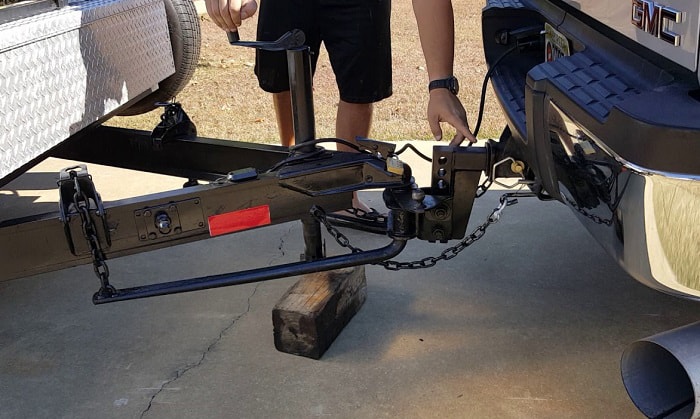
A receiver hitch for travel trailer helps provide an anchor to secure towed loads. Installing a reliable travel trailer towing hitch can help prevent many on-road vehicle-pulling accidents. But what is the best travel trailer hitch on the market?
Buyers should know that no ‘end-all’ model is classified as the one-and-only best tow hitch. Instead, it is important to take a look and think about the different factors associated with searching for an ideal travel trailer hitch system for specific demands.
Some of the things to consider are:
- Unloaded Vehicle Weight: The weight of the towing vehicle from its manufacturing. This reading does not include the weight of any add-ons after the vehicle’s initial purchase development.
- Trailer Towing Capacity: The maximum towing limit of the pulling trailer’s tongue. The pulled load should not exceed the maximum trailer tongue weight. Otherwise, the hitch may fail and release the towed vehicle, even while on the road.
- Towing components: A standard hitch setup for a travel trailer generally uses the following parts: ball mount, trailer ball, safety cables (or chains), a pin, and clip. A reliable RV hitch kit should come with these components. However, these items might also be available as aftermarket purchases.
Remember that the factors mentioned above are not the only elements to consider when shopping for the right travel trailer towing hitch. Keep reading to gain more insight about these elements in greater detail.
First, here is a look at different yet excellent choices for travel trailer hitches.
Table of Contents
Top 11 Travel Trailer Hitch Reviews
1. eaz lift 48059 weight distribution elite kit.
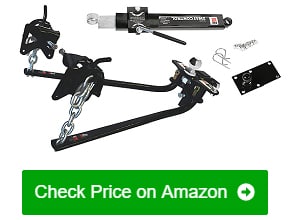
Although travel trailer hitches usually have prices that can break banks, I was content to see this particular model’s costs to be at a mid-range point. Thankfully, the manufacturer did not sacrifice the durability and strength of this model.
It has a 1,200-lb maximum tongue weight with a maximum gross trailer weight rating of 12,000 lbs. I find it surprising that this weight distribution hitch kit can achieve such a feat while maintaining a relatively compact design. That reasonably small frame also made it convenient during removal and storage.
Moreover, the high-quality engineering on the steel construction made this hitch more rugged than other options, especially when compared to the low-quality units I tried.
I would also like to mention that this steel build is a top-notch chrome-molybdenum-grade variant. It means that this kit’s construction can withstand high heat without the significant risk of breaking. It also means that it ensures passengers in the towed motorhome or trailer experience a stable and comfortable ride.
The next feature I adored is the built-in U-bolts. Coupled with the safety chains, I am relieved that this kit has the necessary hardware for a proper and safe installation.
- The mid-range price tag should fit many budget allowances
- Tongue weight capacity and Gross trailer weight rating limit are fairly high
- High-quality chrome-molybdenum-grade steel construction
- Built-in U-bolts enhances convenience and safety during and after installation
- May not be compatible with some travel trailers without modifications
2. Husky 32218 Center Line TS Hitch
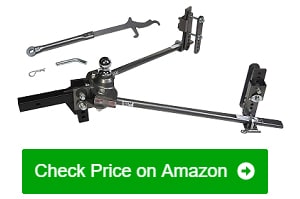
While other trailer hitches only provide secure couplings between towing and towed vehicles, this Husky Center Line TS with spring bars brings weight distribution and built-in sway control in one device.
Furthermore, just about everything I needed for the installation to work is in the kit. In turn, it did not require me to spend time going back to the store.
I also like to mention that this hitch maintained a secure connection after many trips. I tested it for about 17 days while making 26 total camping and road trips. This model performed as intended. I would even go as far as to say it provided me with flying colors for its overall performance.
Initial installation was also a breeze. It took me less than an hour to install it to a 2015 Ford Expedition. But additional testing presented me with some problems with certain towing vehicles possessing uniquely designed pulling tongues. Modifying the kit slightly solved this concern.
- Weight distribution and anti-sway control in one travel trailer hitch
- Complete hardware included in the kit
- Able to withstand strong winds
- Quiet and secure performance for short- to medium-length trips
- Only takes less than an hour to install
- May creak or squeak during long road trips
- Might not fit some towing tongues well without modifications
3. Equal-i-zer Weight Distribution Kit
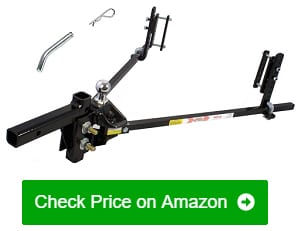
I can safely say that this Equal-i-zer hitch is one of the top-rated weight distribution hitches I have tried. It presented my camper with many benefits, such as the lack of the need to disconnect or disassemble the hitch assembly when backing up my vehicle.
Moreover, this model is also an anti-sway hitch for camper vehicles. It uses a 4-point stabilizing system to help reduce friction and sway during tows. This model also has linear friction at two points, allowing it to provide similar stability as compared to using an add-on 8-point sway control accessory.
Its stability was also on point, seeing that the friction sway control feature also provided a proper weight distribution across my vehicle’s towing tongue. The result is a more convenient and safe ride, including improved steering and braking.
One shortcoming I noticed is that this kit is not the quietest setup in my books. This hitch setup for travel trailer makes a creaking sound while towing a trailer. Additionally, it is not advisable to lubricate the contact area. Doing so will reduce the anti-sway function, increasing on-road risks of accidents.
- No need to disconnect or disassemble the kit while reversing the vehicle
- A 4-point sway weight distribution hitch that removes most side-to-side motions
- Excellent weight distribution to the towing vehicle’s tongue
- Top-notch compatibility for it can fit many vehicles, including utility trailers
- The immutable creaking sound might be an issue for some users
4. Fastway e2 Weight Distribution Kit
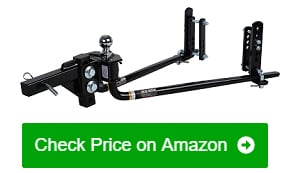
Although the price of this model falls within the average cost of many trailer hitch receivers, it has features that I found to provide me with more value than its overhead. For instance, the traditional spring arms provided my towing setup with an optimal distribution of the weight of both the towing and towed vehicle.
Take note that this setup uses a round bar and a trunnion. The latter component provides towing vehicle users like me with better ground clearance than many other choices on the market.
I also approve that the manufacturer decided to develop a hitch design that does not require disassembly while backing up my vehicle. However, I should mention that this setup that does not require a disconnection should be on a flat surface. Otherwise, attempting it on a steep uphill will still require me to take the system apart.
The install process is also unique as compared to other similar products. I can set this kit up as a front-mounted hitch or connect it to my vehicle’s rear axle. This design also supplies vehicle-pulling options for many users.
Also, this unit has a cohesive anti-sway system. This feature uses friction within the brackets and spring arms to reduce trailer sway from the trailer during tows. It does fairly well in removing unwanted side-to-side motions. But I wish that it does better in eliminating up-and-down movements as well.
- Traditional spring arm design offers optimal weight delivery
- Excellent ground clearance, thanks to a trunnion
- Does not require disassembly when backing up a vehicle on a flat surface
- Can be installed in either the front or back of a towing vehicle
- Anti-sway system efficiently removes side-to-side movements
- 10-year limited warranty
- Might still demand taking the kit apart if the vehicle backs up on a steep hill
5. Andersen Hitches Weight Distribution Hitch
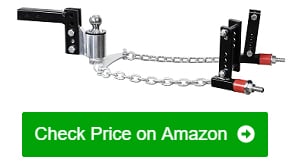
While many hitches with weight-distributing features focus on using the traditional spring bar setup, this Andersen weight distribution hitch revolutionized how these components work. The company removed the conventional spring bar design and created a relatively simpler chain system.
This chain design results in a lighter and quieter towing hitch for campers. In comparison, many other hitches generally weigh more than double what this model has to offer. Its lightweight construction also made it possible to make the install and removal setup easier than others.
Installation is also a reasonably straightforward task, thanks to the detailed instructions. But individuals that wish to purchase this kit should heed my warning: it can be easy to bend the triangle plate and ruin the urethane springs. Therefore, make sure to pay extra care when setting up these parts.
Additionally, I liked that this hitch has two ways to attach and detach from a tow vehicle. First is the use of the provided ¼-in. nut; tightening it will secure the connection, whereas loosening this component undoes the attachment. I can also use an electric trailer tongue jack to do this process faster and with less hassle than before.
- Uses a chain design to make the system lighter and quieter than others
- Straightforward installation, thanks to the detailed instruction manual
- Two options to attach and detach the tow vehicle through this hitch
- Self-lubricating system that does not require extra grease or lubricant
- Requires care not to break some parts during installation
6. CURT 17500 TruTrack Weight Distributing Kit
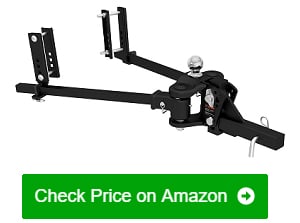
I find this CURT adjustable RV trailer hitch to be one of the more expensive units on the market. But the bump in its price tag is justifiable because it offers a myriad of functional features. One example is its weight rating.
With a 10,000-lb. maximum tow weight rating, along with a 1,000-lb maximum tongue weight rating, this vehicle’s towing capacity exceeds most of its competitors. However, its compatibility limits this tow vehicle weight rating because this unit only fits 2×2-in. trailer hitch receivers.
Moving forward, another feature that I liked about this weight-distributing hitch kit is its five adjustable locations. With it, I can tow multiple vehicles, provided that the maximum trailer weight of all pulled objects does not exceed the system’s allowable load.
I should also mention that distributing the weight is customizable on this kit. This adjustable hitch has a movable shank. Coupled with spring bars that move 30 to 70 degrees, this model can fit many tow vehicle tongues, as long as they have 2×2-inch receivers.
- Maximum tongue weight rating and tow weight rating exceeds many competitors
- Five adjustable locations for towing multiple vehicles
- Adjustable shank to enhance compatibility and flexibility
- Carbide black powder coating provides weather resistance to the system
- Might not be compatible with hitch receivers that are not 2×2-in. in size
7. Ultra-Fab 35-946403 Travel Trailer Hitch Receiver
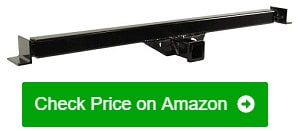
The 53-lb weight of this trailer hitch receiver triggered my skepticism. But this lightweight model is a solid performer on and off the road. Its performance can even outshine some of its heavier competitors.
Starting with the installation, it only took less than 2 hours to complete. The installation process could be faster, but I was chatting with my friend at that time. I should mention that some welding might be necessary to enhance the hitch’s stability and strength.
Furthermore, this trailer hitch is a good choice for towing fairly light objects. I tested it on pulling things like generators and bike carriers. However, anything heavier than about 3,000-lbs will compromise this hitch’s structural integrity.
Still, it can be quite difficult to complain about its shortcomings after seeing its price tag. It is one of the least expensive models on the market for a product of its class. I tried searching for even more inexpensive hitches. The outcome of my search is that I mostly found options that are lacking in quality features.
- Lightweight 53-lb. construction without sacrificing overall performance
- Installation is reasonably quick and easy to complete
- Ideal for towing sufficiently light objects, such as generators and bike racks
- Available at an inexpensive price
- Might not be good for towing anything with a weight heavier than 3,000 lbs.
- Some welding might be necessary to achieve a stable finish
8. CURT 17063 Weight Distribution Hitch
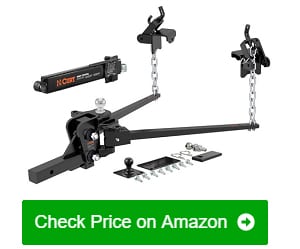
Perhaps the most likable aspects of this weight-distributing trailer hitch are its installation and removal. These procedures did not demand a significant amount of time and effort from my experience.
First, I would like to go about the install process; it starts by mounting the ball and plate onto the trailer frame. Then, I secured these parts using the included self-tapping screws. As for the sway control ball, this component came pre-installed, thus cutting the installation time by quite a bit. Finally, attach its bar to the balls and install the clips.
The removal process is also reasonably straightforward. It only required me to unclip the bar. Then, I followed the install process but in reverse. When I found myself getting stuck with the setup, I can consult the detailed instruction manual for help.
This kit also includes a snap-up lever, which provided my tow vehicle with extra leverage. This feature, it adds extra security for the setup’s assembly.
I should also mention that if I had the hitch head at the highest setting, the maximum extended length is going to be 7 in. At that point, it is a reasonable height to give the tow hitch’s tongue extra ground clearance.
Moreover, I like the build quality on this trailer hitch. Its construction has a corrosion-resistant carbide black powder coating that can also protect the system from harsh weather.
- Installation and removal are reasonably quick to complete
- Snap-up lever provides the setup with extra leverage
- Hitch head offers additional clearance at the highest setting
- Superb corrosion-resistant build quality
- Customers may need to buy compatible sockets for the assembly
9. Husky 30849 Weight Distribution Hitch
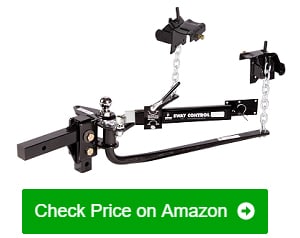
This weight distribution hitch does not only provide optimal balance and stability to tow and towed vehicles; it is also a workhorse. With a weight rating of 1,200 lbs, and a gross trailer weight of 12,000 lbs., this hitch can help pull many objects without the worry of them detaching in the middle of a road trip.
I would also like to circle back to this kit’s stability because this trait is one of this product’s highlights. Using a 2-point anti-sway mechanism, it manages to even out significant rocks or sways that might otherwise come from pulling a heavy load. The manufacturer also gives the option to buy two more sway control balls for extra stability.
After taking the items from its box, the next step was to install this hitch onto my tow vehicle. The installation was reasonably easy because it only took about three major steps to finish the process. First, I ensured that both vehicles were level. Then, I attached the ball. The final step was to secure the chains.
This kit also shines from its built-in pivoting. I managed to pivot the hitch to about eight inch vertically. That pivot range is generally more than what the typical weight distribution hitch can usually offer.
- Above-average 12,000-lb. gross trailer weight and 1,200-lb. tow weight rating
- 2-point anti-sway system for optimal stability
- Option to purchase additional sway control balls for additional stability
- Fairly easy installation
- Able to pivot with an 8-in. range
- The retainer pin might need to be sturdier
10. CURT 13703 Adjustable Trailer Hitch

I found this adjustable trailer hitch to be quite the contender in the midrange category. It has a 3,500-lb gross trailer weight and a 350-lb tongue weight. It contends well with other similar products in its class with those measurements.
That vehicle pulling prowess resonates with the kit’s durable steel build. I found the construction to have a black powder-coated finish to help prevent the unit from corrosion and rust. This coating also aids in preventing damage to the system from the elements, especially from the sun’s UV rays.
Next, I admire this hitch’s versatility. It can accommodate trailer tongues with widths between 22 and 72 in. At that range, this product’s compatibility is reasonably excellent across the board. It can even work on different frame applications, including box, C channel, and I-beam variants.
I also found out that this particular hitch passes the Detroit engineering facility SAE J684 standards. In turn, I am at peace, knowing that this hitch system supplies me with top-rated performance and longevity.
Moving forward, the installation is also fairly easy to finish. One of my test vehicles for this product is the 2008 Jayco fifth-wheel trailer. Installing this hitch onto that RV was not a laborious ordeal.
- Competitive gross trailer and tongue weight
- Durable steel built with black powder coating is resistant to damage
- Versatile hitch that can fit different applications like a box frame
- Easy to install on many compatible vehicles
- May need to buy the hitch clip, pin and lock to complete the installation
11. PSAUTO Adjustable Trailer Hitch
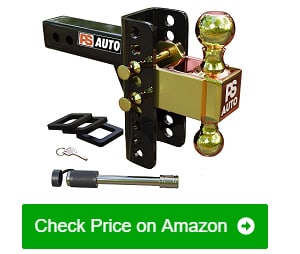
Although it seems that weight distribution hitches dominate the market heavily, I found this model with a trailer ball hitch design can compete with other similar products. I can safely say that previous statement because of this hitch’s many top-notch features, especially its 20,000-lb tow weight capacity.
With this trailer hitch, a compatible towing vehicle can pull more objects than a typical weight-distributing hitch. It even has a distinct channel-style shank, allowing the setup to appear or disappear for convenient use and storage. Also, this system’s weight limit allowed me to say that there might be no such thing as too much weight for towing.
That durable nature also comes with a weather-resistant construction. I left this hitch outdoors for a while to expose it to the elements. Its build withstood the harshness of rain, sleet, and dirt. Even dirt and road grime were not enough to damage the kit’s rugged parts.
But in case this hitch becomes damaged from natural causes, it comes with a limited lifetime warranty. The manufacturer also offers a money-back guarantee to its customers if this product proves to be defective upon purchase.
- Maximum tow weight capacity of 20,000-lbs.
- Unique channel-style shank allows convenient use and storage
- Weather-resistant construction repels damages from the elements
- Limited lifetime warranty and money-back guarantee
- Might do better in removing sways
Travel Trailer Hitches Buying Guide
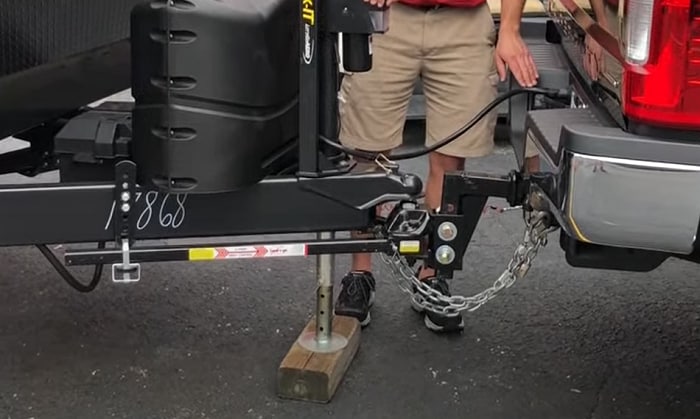
Buying a travel trailer tow hitch without taking the time to research can lead to wrong purchasing decisions. Interested buyers should start their shopping journey by looking at a trailer hitch compatibility chart.
After that initial step, think about these factors while shopping for the most favorite trailer hitch on the market:
Unloaded Vehicle Weight (UVW)
Also known as a travel trailer’s real weight, the UVW represents the weight of the RV with only the load brought by the equipment installed from manufacturing. It does not take into account additional parts like extra hitch accessories.
A tow hitch for travel trailer should support the vehicle’s UVW. Otherwise, installing a mounted hitch with a low lifting capacity can put the trailer’s tongue and the towed vehicle to crash.
Trailer’s Towing Capacity
Trailer owners can find their vehicle’s maximum towing limit by checking their owner’s manuals. If that piece of information is missing, towing vehicle owners can figure out their RVs’ pulling limit by understanding certain elements.
First, it is important to know the different weight ratings of the vehicle. If these details are absent in the owner’s guide, it might be possible to search for the information online. Make sure to use the right key phrases if you need information for specific models, like a bumper pull trailer hitch for a particular vehicle.
Also, the weight ratings required for calculating the towing capacity are:
- Gross Axle Weight Rating (GAWR)
- Gross Vehicle Weight Rating (GVWR)
- Gross Combined Weight Rating (GCWR)
- Gross Trailer Weight Ratings (GTW)
- Tongue Weight (TW)
- Curb Weight
Then, contact the trailer’s maker and give them those numbers. Aside from pulling up information about a travel trailer’s tow capacity from the weight ratings, the manufacturer may also disseminate the correct details about the vehicle’s precise pulling weight limit.
Tow Components
Ideally, the top-tier hitch for towing travel trailer comes as a complete kit. But some manufacturers also offer extra parts for reasonably inexpensive replacements.
A good tow hitch for travel trailer setup usually uses the following parts:
- Ball mount: Often comes with a hitch ball inserted into a trailer hitch receiver and secured with a pin-and-clip assembly.
- Trailer ball: Also called the hitch ball, this component is the attachment point for the trailer and the towing vehicle.
- Tow hitch pin and clip: A small metal bar or rod holding the ball mount and the tube for the hitch receiver.
- Safety cables or chains: Restrains the towed trailer from separating if the coupler or hitch fails.
Additional Features
When looking for the right hitch for travel trailer, it might be tempting to buy a unit with extra functionalities. However, make sure that these add-on items comply with safety regulations.
Some of the relatively common additional features included in some hitches are:
- Extra mirrors: Also called towing mirrors, these pieces of glass allow drivers to gain a better viewing angle than the built-in mirrors on their vehicles.
- Brake control: A feature that connects the towed vehicle’s brakes with the towing automobile’s brake system.
- Rearview camera: Helps drivers avoid obstacles while reversing their towing and towed vehicles.
Another extra feature that many towing vehicle owners often consider is a sway control bar. With it, the trailer can maintain a reasonably straight orientation despite hazards like bad weather or high winds.
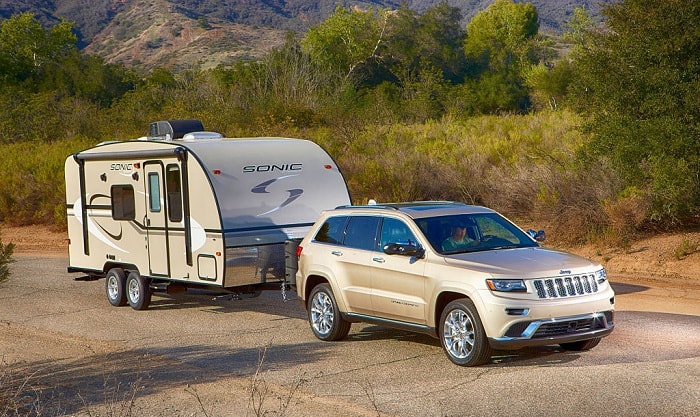
What Kind Of Trailer Hitch Do I Need For A Travel Trailer?
Camper trailer towing hitches come in different types. Understanding the distinct features and traits of the various camper trailer hitch types will help buyers purchase the correct model for their specific needs.
A camper hitch can fall under one of the following categories:
- Front mount hitch: An ideal choice for towing travel trailers at their fronts. It has a similar design to a rear-mounted design, but for the front.
- Gooseneck hitch: Mainly designed for pickups only and has an average weight capacity of 30,000 lbs.
- 5th wheel hitch: Similar to a gooseneck hitch kit, a 5th wheel hitch mounts over or at a slightly forward location of the vehicle’s rear axle. But hitches for 5th wheels can often only hold up to 24,000 lbs.
- Bumper hitch: As its name implies, this camper receiver hitch attaches directly to the vehicle’s bumper.
- Pintle hitch: It can be easy to mistake a pintle hitch with a model with a ball mount design because of their designs. But a pintle trailer hitch for camper has a hook with the same name as this hitch category.
- Weight distribution hitch: It is possible to mount a weight distribution system to either the front or rear of the vehicle. As its name dictates, this type of tow hitch distributes the trailer’s tongue weight across the towed trailer and the towing vehicle.
Buyers may use specific keywords like Hensley weight distribution hitch to look at the different models on the market. Precise key phrases can also aid in filtering search results, streamlining the online shopping experience.
Which Is Better Class 2 Or Class 3 Trailer Hitch?
Class 2 and Class 3 trailer hitches supply users with benefits often unique to each travel trailer tow hitch class. The following list is a quick look for some of the relatively common characteristics of Class 2 and Class 3 trailer hitch accessories:
Class 2 Trailer Hitch Receiver
- 350-lb. maximum tongue weight capacity
- 3,500-lb. maximum gross travel trailer weight capacity
- Ideal for hauling a bike rack or a small boat
- Fairly inexpensive
Class 3 Trailer Hitch Receiver
- 800-lb. maximum tongue weight capacity
- 8,000-lb. maximum gross weight rating
- Ideal for pulling medium boats and campers
- Reasonably more expensive than Class 2s
What Is The Strongest Drop Hitch?
A steel drop hitch for travel trailer will generally outperform other hitch accessories, such as those made from aluminum, when talking about durability and maximum weight capacity. With steel, it can provide a sufficiently long serviceable life for its users, thanks to its rigidity.
This sturdiness generally also comes with optimal support. Steel weight distribution hitches work well in flat and uneven terrain, reducing unwanted movements from the trailer’s tongue.
Does Weight Distribution Hitch Help With Sway?
Some weight distribution hitches have sway controls to help reduce side-to-side motions. Certain models may also perform better than others by supplying towing and towed vehicles with up-and-down motion reduction features. In the case your hitch trailer happens to shake and cause an annoying rattle. I recommend owning an anti rattle hitch device. Click here to lean more an article about them.
How Do I Know If My Hitch Is Class 1 Or 2?
Aside from consulting the product’s owner’s manual or asking the manufacturer, figuring out if a towing hitch for a travel trailer is Class 1 or Class 2 is possible by understanding the distinct features of each class.
Here is a quick look at the fairly common traits in Class 1 and Class 2 travel trailer hitches:
Class 1 Travel Trailer Hitch
- Often designed for domestic and foreign passenger cars
- Typically has a gross vehicle weight rating of 2,000 lbs.
- It is generally a small trailer hitch made for towing light-duty trailers
Class 2 Travel Trailer Hitch
- Often designed for passenger vehicles and light-duty trucks
- Generally has a tongue weight capacity of 350 lbs.
- Usually built for towing a boat or camper and mounting a cargo carrier.
Using the best travel trailer hitch presents users with different benefits. Some of these advantages may include (but are not limited to) enhanced durability, stability, and long serviceable life.
It is possible to get the most out of a hitch if buyers choose my suggestion, which is the CURT 17063 Weight Distribution Hitch. This model is easy to install and remove, provides great clearance, leverage and has a top-rated corrosion-resistant construction.

Hi, I am Joseph. Carpe diem! Seize the day! That’s always been my life motto. If you haven’t seen some of the most beautiful places in the country, you are missing out on incredible adventures.

- Types Of RVs
- Tow Vehicles
- Maintenance & Repairs
- RV Power & Electrical Supplies
- RV Appliances
- Living In An RV
- Travel & Destinations
- RV Gear Buyer’s Guides
![8 Best Stabilizer Hitches for Travel Trailers in [currentyear]: Find the Perfect Weight Distribution Hitch 1 Best Weight Distribution Hitch](https://www.rvingknowhow.com/wp-content/uploads/2020/06/Best-Weight-Distribution-Hitch.jpg)
8 Best Stabilizer Hitches for Travel Trailers in 2024: Find the Perfect Weight Distribution Hitch
- Last Updated: August 25, 2024
- 40 minutes read
As someone who has rigorously tested numerous stabilizing solutions for travel trailers, I understand the importance of having a reliable weight distribution hitch to ensure safety and comfort on the road.
The right hitch can significantly alleviate the swaying and instability that often plagues trailers, making your journey smoother and worry-free.
Among the variety of options I’ve evaluated, focusing on anti sway hitch and spring bar technology specifically designed for travel trailers, one product stood out distinctly.
After testing 8 top contenders in the market, the Blue Ox BXW1000 SWAYPRO Weight Distributing Hitch earned its place as my best overall recommendation.
This hitch excels in providing superior sway control and weight distribution, ensuring your trailer remains steady in various driving conditions.
Based on my experience, the top stabilizer hitches for travel trailers are:
- Blue Ox BXW1000 SWAYPRO Weight Distributing Hitch : Best overall for its exceptional sway control and weight distribution.
- EAZ LIFT 48053 Elite Bent Bar Weight Distributing Hitch : Great for its bent bar design that enhances stability.
- Husky 32218 Center Line TS with Spring Bars : Excellent for integrating weight distribution and sway control in a robust design.
- Reese Pro 49903 Weight Distributing Hitch : Ideal for its versatility and ease of use.
- CURT 17063 MV Weight Distribution Hitch with Sway Control : Top choice for those seeking a durable and reliable option with integrated sway control.
- Camco Eaz-Lift ReCurve R6 Weight Distributing Hitch Kit with Sway Control : Perfect for those who prioritize easy setup and effective sway control.
- Andersen Hitches 3350 No Sway Weight Distribution Hitch : Best for its no-sway technology and lightweight design.
- Fastway 10K RB Fastway e2 2-point Sway Control Distribution Hitch : Good for its straightforward installation and efficient sway control mechanism.
8 Best RV Weight Distribution Hitches for Safe and Stable Towing
1. best overall: blue ox bxw1000 swaypro weight distributing hitch.
![8 Best Stabilizer Hitches for Travel Trailers in [currentyear]: Find the Perfect Weight Distribution Hitch 2 Blue Ox BXW1000 SWAYPRO Weight Distributing Hitch 1000lb Tongue Weight for Standard Coupler with Clamp-On Latches](https://www.rvingknowhow.com/wp-content/uploads/2024/02/31Mj36HuqiL._SL500_.webp)
The Blue Ox BXW1000 SWAYPRO is our pick for the best overall weight distribution hitch because it comes with a pre-adjusted hitch head that doesn’t require any further fine-tuning once it’s installed.
That’s not always the case with these hitches and it makes this a great choice if you don’t have a ton of experience using them.
This trunnion-style hitch has excellent sway control which allows you to tow at faster speeds without worrying about your trailer fishtailing behind you.
Trunnions on either side of the hitch head work together with the hitch’s spring bars to create a caster effect. This effect continuously pushes inward to keep everything in line.
You’ll also be able to navigate easier when you arrive at a new campground. Some locations have tight turns and others require you to back up to get into your site.
With this hitch, you won’t have to disconnect in order to back up. But when you do want to disconnect, it’s super easy to do so.
It takes just minutes to connect and disconnect to this hitch, which gives you the freedom to drop your trailer or vehicle without any added headaches.
If the tongue of your trailer already boasts a coupler welded to the top of the frame and it doesn’t have any cross-members on the tongue, you’ll be able to utilize this hitch out-of-the-box.
It is compatible with other trailer tongues, however. You just may need to purchase additional bolt-on latches or an optional hitch head to ensure safe towing.
The Blue Ox BXW1000 has a maximum tongue weight rating of 1,000 pounds and a maximum gross weight rating of 10,000 pounds.
It also boasts spring steel construction that adds durability and strength to the entire unit and you won’t have to disconnect this hitch when you need to back your trailer up.
Things We Like
- Sway Control: Keeps everything in line so you avoid fishtailing.
- Pre-Adjusted Hitch Head: Requires no additional fine-tuning after installation.
- Easy Connection: The spring bars on this hitch are self-locking.
- Clamp-On Latches: Don’t require the use of any additional hardware for installation.
Things We Don’t Like
- Compatibility: Works best with trailer tongues with coupler welded to the top of the frame and without cross-members on the tongue.
- Price: You’ll pay a little extra for the quality of this hitch.
2. Best Budget-Friendly: EAZ LIFT 48053 Elite Bent Bar Weight Distributing Hitch
![8 Best Stabilizer Hitches for Travel Trailers in [currentyear]: Find the Perfect Weight Distribution Hitch 3 EAZ LIFT Camco Eaz-Lift Elite 1,000lb Weight Distribution Hitch with Height Adjustable Forged Shank (48053)](https://www.rvingknowhow.com/wp-content/uploads/2024/02/41nnAFIsw8L._SL500_.webp)
The EAZ LIFT 48053 weight distribution hitch is the most budget-friendly round bar hitch we could find on the market today.
The good news is that you won’t have to severely sacrifice quality to get a hitch that fits your budget.
EAZ LIFT is actually made by Camco, which is one of the more reliable brands in the industry.
It comes with an adjustable ball mount but does not include the hitch ball itself. So you’ll have to grab this accessory separately to make this hitch work for you.
The bars on this hitch, however, are actually interchangeable. This is uncommon amongst this type of hitch but it serves to provide a smoother ride.
The bars use positive latching action to attach to your trailer tongue and the round spring bars on this hitch are machine tapered and forged longer for added strength and durability.
These spring bars can actually be removed if you chose to operate it as a more standard weight distributing hitch. Doing so, however, significantly reduces the hitch’s tongue weight and gross weight ratings.
The hitch is adjustable to fit many different trailer-vehicle combinations and it comes with clips and bolt package for easy installation.
The shank size is 2” x 2” with a 10-inch length, a 2.5-inch drop, and a 5.5-inch rise.
The entire package is also backed by the manufacturer’s 5-year warranty, which is always a good sign when it comes to your safety and the safety of your vehicle/trailer investments.
The EAZ LIFT 48053 also has a maximum tongue weight of 1,000 pounds and a maximum gross weight rating of 10,000 pounds. If you remove the spring bars, however, those ratings drop down to 600 pounds and 6,000 pounds, respectively.
- Price: It’s the most budget-friendly hitch on our list.
- Versatility: Spring bars can be removed to use it as a more standard hitch.
- 5-Year Manufacturer’s Warranty: Camco stands behind the quality of their product.
- Adjustable Hitch: Can adapt to fit a variety of trailer-vehicle combinations.
- Hitch Ball Not Included: You’ll have to purchase a compatible hitch ball separately.
3. Best For Quiet Use: Husky 32218 Center Line TS with Spring Bars
![8 Best Stabilizer Hitches for Travel Trailers in [currentyear]: Find the Perfect Weight Distribution Hitch 4 Center Line TS Weight Distribution Hitch - 2-5/16" Ball - 12,000lbs](https://www.rvingknowhow.com/wp-content/uploads/2024/02/3164m3UjsvL._SL500_.webp)
If you’re looking for a trunnion-style hitch that doesn’t cause a bunch of extra noise while you’re driving down the highway, check out the Husky 32218 Center Line TS.
Annoying noise can be an issue with other sway bars and weight distribution products, but that’s not the case with this hitch.
One of the reasons for this noise reduction is the fact that this hitch doesn’t use chains to attach to the tongue of your trailer.
Those chains jangling around are primarily what causes the noise in other models. But you’ll be able to hear (and feel) the difference when you drive with this hitch.
The unit combines sway control and weight distribution to provide quiet performance without the need for any additional hardware. This makes it super easy to install.
The handles on the bars further aid in securing them to (and removing them from) your trailer and the frame brackets are easily adjustable to mount on a variety of trailer tongues.
The Husky 32218 Center Line TS has a maximum tongue weight rating of 1,200 pounds and a maximum gross weight rating of 12,000 pounds.
The hitch itself weighs a total of 116 pounds, which is lighter than many. This lighter weight makes it easier to install and remove as needed.
- Quiet Operation: No noisy chains like other hitches.
- Built-in Sway Control: Doesn’t require installation of any additional hardware or accessories.
- Lightweight: This is a relatively lightweight hitch compared to similar models.
- Easy Installation: Handles on the frame brackets make it easier to install.
- Compatibility: This hitch is built for a 2 and 5/16” hitch ball.
4. Best With Preinstalled Hitch Ball: Reese Pro 49903 Weight Distributing Hitch
![8 Best Stabilizer Hitches for Travel Trailers in [currentyear]: Find the Perfect Weight Distribution Hitch 5 Reese Pro 49903 Round Bar Weight Distribution Kit with Sway Control](https://www.rvingknowhow.com/wp-content/uploads/2024/02/31u9q1VtAML._SL500_.webp)
The Reese 49913 Wd Rb Pro round bar hitch is a great option if you’re looking for a weight distribution hitch with a preinstalled hitch ball.
This means you won’t have to worry about finding a hitch ball separately and risk picking one that’s not compatible. With a preinstalled hitch ball, compatibility is a non-issue.
The hitch ball is 2 and 5/16ths of an inch in diameter and it arrives already torqued to the hitch head.
The spring bars on this hitch are tapered to provide more even weight distribution over your trailer axles.
This provides an even smoother ride and the include friction sway control prevents fishtailing at high speeds.
For an RV accessory that’s consistently exposed to dirt, debris, rain, and other elements, it’s important to know it’s going to last.
That’s why I like the fact that all the metal components of this hitch are finished with powder coating.
This finish improves the overall corrosion resistance and durability of the hitch over its lifetime.
In addition, the clamp-on brackets that come with this hitch are designed to fit trailer frames up to seven inches in diameter.
While this hitch won’t be compatible with larger trailer frames, the brackets don’t require any drilling to be installed properly.
This hitch also fits taller trucks with a two-inch shank size and an 8.5-inch drop.
The Reese 49913 Wd Rb Pro has a maximum tongue weight rating of 1,150 pounds and a maximum gross weight rating of 11,500 pounds.
It is also backed by the manufacturer’s 10-year limited warranty if certain components require repairs or replacement.
- Preinstalled Hitch Ball: Comes with a 2 and 5/16” hitch ball preinstalled.
- Powder Coat Finish: Improves corrosion resistance over the life of the hitch.
- 10 Year Warranty: The manufacturer offers a 10-year limited warranty on this hitch.
- Tapered Spring Bars: Provide more even weight distribution over the axles.
- Compatibility: Made to fit only bottom mount couplers.
- Specific Clamp Brackets: These brackets are designed to fit trailer frames only up to seven inches.
5. Best Gross Trailer Weight Rating: CURT 17063 MV Weight Distribution Hitch with Sway Control
![8 Best Stabilizer Hitches for Travel Trailers in [currentyear]: Find the Perfect Weight Distribution Hitch 6 CURT 17063 Round Bar Weight Distribution Hitch with Integrated Lubrication and Sway Control, Up to 14K, 2-In Shank, 2-5/16-Inch Ball , Black](https://www.rvingknowhow.com/wp-content/uploads/2024/02/4100TmBvPL._SL500_.webp)
If you’re in search of a weight distribution hitch with a high gross trailer weight rating, look no further than the CURT 17063 MV Round Bar hitch.
This hitch is the best option for anyone that needs to tow a longer trailer and it has a lot of great features to keep that extra length in line with your towing vehicle.
For starters, it provides more level towing by more evenly distributing the tongue weight of your trailer across the area of the vehicle-trailer combination.
In conjunction with the included sway control bar, your trailer will stay more level while you’re driving than with many other distribution hitches.
In order to improve sound on the road, this hitch includes an integrated lubrication system.
This system provides continuous lubrication through the use of two easy-access grease zerk fittings on the hitch head.
These fittings are built directly into the head and provide lubrication at the spring bar mounting location.
Speaking of the spring bars, they are each 31 and 1/16th of an inch long and made of forged steel.
The pre-torqued hitch ball is 2 and 5/16th of an inch in diameter and the shank size is 2” x 2”.
This shank size makes it compatible with class 3, class 4, and even the heaviest of class 5 trailer hitches.
The CURT 17063 MV Round Bar has a maximum tongue weight rating of 1,400 pounds and a maximum gross weight rating of 14,000 pounds.
It also boasts a durable black carbide powder coat finish to add durability and corrosion resistance to the components.
- Adaptability: Standard shank size fits class 3, 4, and 5 trailer hitches.
- Continuous Lubrication: Lubrication at the spring bar mounting location ensures a smoother ride.
- Level Towing: More even weight distribution at the tongue makes your trailer ride more level.
- Gross Vehicle Weight Rating: This hitch is rated a maximum gross weight of 14,000 pounds.
- Performance in Tight Spaces: Some users reported the need to disconnect the sway control bar when making tight turns, especially to the right.
6. Extra Ground Clearance: Camco Eaz-Lift ReCurve R6 Weight Distributing Hitch Kit with Sway Control
![8 Best Stabilizer Hitches for Travel Trailers in [currentyear]: Find the Perfect Weight Distribution Hitch 7 Camco Eaz-Lift ReCurve R6 Weight Distributing Hitch Kit with Adjustable Sway Control - 1000 lb. Tongue Weight Capacity |Heavy Duty and Rust Resistant Design - (48733)](https://www.rvingknowhow.com/wp-content/uploads/2024/02/31Kq8QQ3ySL._SL500_.webp)
If you consistently take your trailer to locations that require a little extra clearance, the Camco Eaz-Lift ReCurve R6 top-loading round bar hitch is one of the best in the business.
It’s specifically designed to provide more ground clearance than other hitches and the model’s sway control can temporarily be disengaged to provide better performance in icy or dangerous road conditions.
Unlike many hitches, the spring bars on this one are top-loading. This design feature creates more ground clearance and also makes them much easier to install.
This feature is aided by the fact that the shank itself only has a maximum drop of ¾”. It does provide a maximum rise, however, of seven inches.
Camco specifically designed this hitch to be one of the most user-friendly models in their fleet.
In doing so, they created a system that automatically disengages the sway control function when you turn.
With other hitches, the sway control function can essentially “lock” your trailer straight and it must be manually disengaged for tight turns or navigating into a campsite.
That isn’t the case with the ReCurve, which makes it much easier and efficient to navigate tight campgrounds or get your trailer into position in trickier spots.
This model comes with a 2 and 5/16” hitch ball and a 2” square hitch bar with a length of 12 inches. The spring bars themselves are 30 inches long.
The Camco Eaz-Lift ReCurve R6 has a maximum tongue weight rating of 1,000 pounds and a maximum gross weight rating of 10,000 pounds.
Like other good hitch models, the metallic components of this one are finished with powder coating to length their lifespan and provide added corrosion resistance.
- Ground Clearance: This hitch has a maximum rise of seven inches and a drop of only three-quarters of an inch.
- Top-Loading Spring Bars: This design further improves this hitch’s ground clearance.
- Sway Control Function: Automatically disengages on tight turns to make it easier to navigate.
- Adaptability: The sway control can also be completed turned off for better control in icy or otherwise dangerous road conditions.
- Price: This is definitely not the cheapest hitch on our list.
- Pin Design: Some users reported issues removing pins to re-position frame brackets after initial installation.
7. Best Anti-Sway and Anti-Bounce: Andersen Hitches 3350 No Sway Weight Distribution Hitch
![8 Best Stabilizer Hitches for Travel Trailers in [currentyear]: Find the Perfect Weight Distribution Hitch 8 Andersen Hitches 3350 | No Sway Weight Distribution Hitch | 4" Drop-Rise | 2 5-16" Ball | 3", 4", 5", 6" Universal Frame Brackets | Includes 2 Bumper Stickers](https://www.rvingknowhow.com/wp-content/uploads/2024/02/41zrNmtuJoL._SL500_.webp)
If you’re looking for a true pioneer in the weight distribution hitch industry, check out the first-in-its-industry features of the Andersen Hitches 3350.
This Andersen hitch is the first to include both anti-sway features and a motion dampening system that keeps your trailer from bouncing up and down at higher speeds.
The sway control functionality of this model is self-adjusting. This means it won’t lock you up on tight turns or when you’re navigating into a tricky campsite.
You’ll also be able to back your trailer up with this hitch still attached. So it can allow for more efficient trailer travel when compared to some other hitches.
The hitch ball that comes with this unit is 2 and 5/16ths of an inch in diameter.
It can actually double as a standard hitch ball if you ever need to tow anything without concern for weight distribution.
The hitch bar itself fits a two or 2.5-inch receiver and secures in place with a single pin. This guarantees easy installation and removal as needed.
This model has a maximum drop and rise of four inches, but you can purchase an eight-inch adjustable rack if you need additional drop or rise.
You also won’t need to worry about lubricating the ball and coupler regularly. They move as one as part of Andersen’s unique grease-free system.
The Andersen Hitches 3350 has a maximum tongue weight rating of 1,400 pounds and a maximum gross weight rating of 14,000 pounds when installed with the standard two-inch rack.
But it can actually handle a gross weight up to 16,000 pounds when installed with the 2.5-inch rack.
- Better Control: This is the first hitch of its kind to reduce both trailer sway and trailer bounce.
- Frame Bracket Adaptability: Brackets adjust to fit 3”, 4”, 5”, and 6” trailer frames.
- Grease-Free System: The ball and coupler actually move as one unit so no extra lubrication is required.
- Easy Installation: No pry bars needed!
- No Spring Bars: It relies, instead, on chains that can produce more noise on the road.
- Customer Service: Some users have reported trouble getting in touch with Andersen customer service.
8. Best Lightweight: Fastway 10K RB Fastway e2 2-point Sway Control Distribution Hitch
![8 Best Stabilizer Hitches for Travel Trailers in [currentyear]: Find the Perfect Weight Distribution Hitch 9 Fastway e2 2-Point Sway Control Round Bar Hitch, 94-00-1061, 10,000 Lbs Trailer Weight Rating, 1,000 Lbs Tongue Weight Rating, Weight Distribution Kit Includes Standard Hitch Shank, Ball is Included](https://www.rvingknowhow.com/wp-content/uploads/2024/02/31PqLRXdIOL._SL500_.webp)
The most lightweight round bar hitch on our list is the Fastway 10K RB e2 hitch.
It weighs a total of just 33 pounds, which is lighter than the nearest competitor by a wide margin.
This lighter weight makes the hitch and accompanying spring bars much easier to install and remove as a single person, whereas others might require at least two people for easier installation.
Despite its lightweight design, the rigid steel brackets on this unit mount directly to your trailer frame to prevent sway.
They do so by creating steel-on-steel friction and consistently applying pressure inward.
The sway control on this hitch is also completely built-in, which means you won’t have to install or connect any additional parts or hardware.
The hitch is designed to be back-up friendly, which means you won’t have to disconnect it every time you need to back into a new campsite. This can be an issue with other hitches, but not with the e2.
It also has the added advantage of being very adaptable ot many trailer types because the brackets are easily installed around gas tanks and battery boxes that are sometimes mounted on the trailer tongue.
The Fastway 10K RB e2 has a maximum tongue weight rating of 1,000 pounds and a maximum gross weight rating of 10,000 pounds.
The Fastway e2 hitch is also available in at trunnion-style if you require additional ground clearance. Or you can pop back up and check out the ReCurve R6.
- Product Weight: This distribution hitch weighs just 33 pounds.
- Built-in Sway Control: Keeps your trailer in line in without requiring any add-ons.
- Rigid Brackets: Create steel-on-steel friction to prevent sway.
- 10 Year Warranty: Covers repairs or replacements on most parts and components.
- No Hitch Ball Included: This unit works with a 2 and 5/16ths of an inch ball, but it doesn’t come with one.
How To Pick The Perfect Weight Distribution Hitch?
The right hitch for your situation will largely depend on compatibility with both your RV and your towed vehicle.
In this Buying Guide, we’ll cover the main factors that will help you determine whether a certain hitch will work for your RV-vehicle combination.
Types of Weight Distribution Hitches
There are three main types of weight distribution hitches. We’ve included at least one of each in our reviews above, so it’s important that we take some time to understand a little more about each type.
Round Bar Hitches
This type of hitch features round sway bars that attach to the bottom of the trailer ball mount. Their main advantage is compatibility with many different vehicle-trailer combinations.
But they have less ground clearance than other hitch types, so potholes or bumps can present problems.
Trunnion-Style Hitches
Trunnion-style hitches have much more ground clearance than a round bar or Andersen hitch.
The sway bars on this style of hitch also don’t require clips, but the downside of this hitch type is that it can be difficult to adjust the height of the hitch head.

Andersen Hitches
Andersen hitches completely ditch solid sways bars in favor of chains and dampers.
This hitch design does very well to reduce both swaying and bouncing, which is nice if you frequent rough roads or like to take your trailer off-road.
Gross Trailer Weight
The gross weight of your trailer includes the factory weight as well as the weight of any additional cargo or modifications.
Many new trailer owners forget to take these additional weights into account when they purchase a new hitch system, which can result in buying a hitch that isn’t rated highly enough.
To put it very simply, you need a weight distribution hitch that’s rated for more weight than the total weight of your trailer and all of its cargo.
If your trailer is too heavy for the hitch, it won’t be capable of properly distributing the weight. It will essentially be rendered useless and your trailer will still be more likely to sway or bounce.
Tongue Weight
Tongue weight is the percentage of the load that rests directly on the hitch. It is actually a combination of the weights of the front end of your trailer and the back end of your towing vehicle.
As a general rule of thumb, the tongue weight is typically about 10 to 15 percent of the gross trailer weight.
You should always choose a hitch that’s rated to handle more than the actual tongue weight of your trailer-vehicle combination.
If you can’t perfectly calculate the exact weights of the front end of your trailer and the back end of your towing vehicle, using the 10 to 15 percent rule of thumb is a great way to determine how much tongue weight your ideal weight distribution should be rated to handle.
Installation Process
Some hitches are much easier to install than others. But all of them will require a little bit of time and effort.
When selecting a weight distribution hitch, make sure to choose one with a relatively simple install process.
It should also come with a clear instruction manual that’s written precisely in the language you’re most comfortable with.
Most manuals should provide instructions in multiple languages, but this is indeed something to check on before buying.
And one great way to do that is by reading into user reviews of the specific hitches you’re interested in.
If you can find a hitch that users are continuously reporting to be easy to install, you can rest assured that your own process won’t become a tedious headache.
In general, the installation process for these hitches shouldn’t take more than one hour.
If you’re finding reviews that state it took multiple hours to install a certain hitch, you might be well served avoiding that product.
But you always need to be careful not to judge a hitch based on a single user review. Look for patterns and identify the experience that the majority of users are reporting.
A weight distribution hitch with a simple installation process should require between 30 minutes and one hour to set in place properly.
Types Of Sway Control
Almost all weight distribution hitches have some form of sway control. But the way they work can be drastically different.
One type of sway control is designed to reduce sway once it has begun. The other is designed to prevent swaying from starting in the first place. We’ll go over each type in more detail.
Sway Controls To Reduce Sway
Hitches that serve this purpose either rely on independent friction sway control or dependent sway control.
Independent friction control devices on weight distribution hitches typically look like a bar that attaches to the frame of your trailer.
Because the bar is attached to both the hitch and your trailer, it can provide tension to keep your trailer straighter behind your vehicle.
The bar is usually telescoping so that it can extend or retract as your trailer moves.
If your trailer starts to move out of line, the friction pads within the telescoping arm of the bar keep it from extending too far, which cuts down the side-to-side movement of your trailer.
Dependent sway controls are actually built right into a weight distribution hitch.
When your trailer begins to swing, the downward force created by the hitch’s spring bars creates frictional resistance on the brackets connected to your trailer frame.
Some dependent sway control devices rely on steel-to-steel resistance. Others include a material that is similar to the brake pads on a vehicle.
Either way, the resistance created is designed to keep your trailer in a straight line.
Sway Controls To Prevent Sway From Starting
There are various types of weight distribution hitches with sway controls designed to prevent sway from beginning in the first place.
One such device relies on sliding devices called ‘cams.’ These ‘cams’ suspend the spring bars and lock into position.
With one end of the cam aligned to the lift bracket and the other to your trailer frame, the springs bars are set in place. This placement of the spring bars is what keeps your trailer aligned.
Some hitches have four points of sway control built-in. This entails a secure connection between the hitch head and the spring bars.
Through these connections, the spring bars are held tightly in place and the amount of tension and resistance in the system is enough to keep your trailer in line.
Still other hitches rely solely on tension to keep the spring bars tightly in place. And there are also systems with active sway control that rely on spring-loaded ball bearings.
These bearings apply pressure inside the detents in order to keep the trailer straight.
Product Weight
The weight of the weight distribution hitch you choose should be taken into account when you’re making sure that the total weight you’re hauling doesn’t exceed your vehicle’s specifications.
While these hitches help to more evenly distribute the weight of your trailer and rear axle of your tow vehicle, they can’t actually increase the maximum towing capacity of your vehicle.
But the weight of the hitch you choose also comes into play when you have to install or remove it.
Most of these hitches weight at least 100 pounds, but some are considerably heavier while others are noticeably lighter.
Simply make sure that you’re comfortable handling the weight of the hitch you choose when it comes to installing it between your tow vehicle and your trailer.
Pre-Installed Components
The best weight distribution hitch models come ready-to-use right out of the box. They include all of the pre-installed components necessary for easy installation and safe operation.
Many also include a package of clips and pins to secure the hitch bar, brackets, and other elements in place.
But other hitches don’t come with everything you need to start using them immediately. Some don’t include a hitch ball and you’ll have to buy that separately.
Others might require additional hardware to be compatible with your specific trailer-vehicle combination.
If this becomes the case for you, you’ll have to incur an added expense to make the hitch you’ve already bought work with your trailer. And that’s not always the easiest task to complete.
So we recommend looking for a hitch that comes with pre-installed components.
Taking this route will also reduce the likelihood that anything happens during the installation process that causes the entire weight distribution system to be dangerous or ineffective.
As you might expect, these hitches are subject to the elements. Roadways can be harsh environments for any exterior components of your trailer and vehicle, but your hitch rests firmly in between the two.
And this positioning can place even more stress on the hitch and its components. That’s why you need to consider the durability of a given hitch in your buying process.
The most durable hitches on the market include a powder-coated finish to whatever metal is used in their construction.
This powder coating provides an added degree of corrosion-resistance that extends the longevity of your hitch and its components.
If you live or frequently travel to locations close to the ocean, you probably already know the effect that salt in the air can have on metal parts.
So a hitch with a powder-coated finish is essential for these areas.
But the durability of a weight distribution hitch extends a little bit beyond whether or not it has a corrosion-resistant finish.
The quality of the metal used in the hitch’s construction also comes into play.
Perhaps the easiest way to ensure that your final hitch choice is going to last is to consult a host of consumer reviews.
You can be confident that any product with a durability issue is going to have plenty of reviews in which that issue is well documented.
Again, be careful to trust the “law of averages” when it comes to consulting these reviews.
But they can still be a very helpful tool in determining whether or not a hitch will actually hold up as well as its manufacturer claims.
How much does a weight distribution hitch cost?
When it really comes down to making a final decision on a hitch, we know that its price is going to come into play. And we recognize that these hitch systems aren’t always super affordable.
But we also think it’s important to point out that what we’re really talking about here is an investment into your personal safety, your family’s safety, and the safety of the investments you’ve made in your trailer and your tow vehicle.
We know that some of those things are hard to put a price on, and there are ways to reduce trailer sway without purchasing a weight distribution hitch.
But the best ways to ensure safer towing are to purchase a quality weight distribution hitch and apply some of those safe driving techniques.
In the process of setting your budget for a weight distribution hitch, it’s good to get a sense of the high and low ends of the market.
This will give you a range in which most hitches will fall, and then you can more easily decide which end of that range you’d like to select from.
So, What is the Best Weight Distribution Hitch for 2020?
As we stated in our initial reviews, we stand by the Blue Ox BXW1000 as the best overall weight distribution hitch.
It gets our vote here because it’s super user-friendly if you’re new to the world of towing a trailer.
The latches that attach to your trailer frame don’t require any additional hardware and the entire hitch can be installed or removed in just a few minutes.
But, coming in a close second, we’d also highly recommend the Camco Eaz-Lift ReCurve R6 hitch.
This is because it offers more ground clearance than the majority of weight distribution hitches on the market.
This extra clearance will definitely come in handy if you like to travel off the beaten path.
Frequently Asked Questions About WDH
While these hitches aren’t overly complicated, there’s still quite a bit to learn if you’re buying your first one.
So let’s briefly address the most frequently asked questions about weight distribution hitches.
What size hitch do I need?
The main factor that will determine your hitch size is the weight of your trailer (or towed vehicle).
A hitch’s size is usually determined using two ratings: one for maximum gross trailer weight and the other for maximum tongue weight.
These two ratings are very commonly advertised when you’re shopping for weight distribution hitches.
If it’s hard to find these ratings for a particular model, that’s an automatic red flag.
To pick the right size hitch for you, make sure that these ratings are both higher than the gross weight of your trailer and its tongue weight.
These weights should be relatively easy to find in the specifications for your trailer, whether that’s online or in the owner’s manual.
But you should also be careful not to choose a hitch that’s rated too high. If your actual tongue weight is much less than what your hitch is rated for, it can actually make towing unpredictable and more dangerous.
On the other hand, a hitch that’s rated for less than the actual tongue weight of your trailer won’t be able to adequately distribute the load and, in that case, there’s not much point in having it.
How does weight distribution really work?
These hitches work by distributing weight away from the tongue of your trailer and onto the other axles of your vehicle.
Without weight distribution, all of the weight of your trailer gets concentrated on the rear axles of your towing vehicle.
With weight distribution, that weight gets spread to the front axle of your towing vehicle and the axles of your trailer itself.
This effect becomes really helpful for not exceeding the gross vehicle axle weight limit of your towing vehicle.
As a general rule-of-thumb, you should consider a weight distribution hitch if the weight of your trailer is more than half of the weight of your towing vehicle.
Can you further explain sway control?
Sure! Breaking it down briefly, there are devices that reduce sway once it has begun and others that are designed to prevent sway from starting in the first place.
Most of the best weight distribution hitches have one of these two forms of sway control built-in.
How do I know how much my vehicle can tow?
It’s important to note that none of these hitches boast the ability to increase the amount of weight that your vehicle can tow.
It safely makes towing a trailer safer and makes your trailer less likely to fishtail or bounce at higher speeds.
Your vehicle’s rating for the maximum amount of weight it can tow safely and legally should be in your owner’s manual.
Otherwise, you can most likely find the specifications online as long as you know the exact year, make, and model of your vehicle.
If you can’t find the information online and you’ve misplaced your owner’s manual, you can always call the dealership that you bought your vehicle from.
This, of course, only works if you bought from a dealership and not a private seller.
But going directly to the manufacturer can still be a good way to find your vehicle’s towing specifications if you did purchase from a private party.
What are the main problems with towing a trailer without a weight distribution hitch?
The two main problems that occur when towing a trailer are called ‘dive’ and ‘sway’. If the tongue weight is too large in comparison to your gross trailer weight, the trailer will ‘dive’.
This basically occurs when there is too much weight placed on the hitch junction between your vehicle and your trailer.
This excessive weight causes the tongue of the trailer and the rear axle of your tow vehicle to dive down together.
This creates a sort of ‘taco effect’ that will be visible to the naked eye if it’s occurring. The back of your trailer will be noticeably higher than the front once it’s loaded onto your trailer hitch.
You’ll also be able to see the nose of your tow vehicle visibly higher than the rear bumper. The danger of a ‘dive’ comes when you try to brake quickly.
The added downward force placed on the hitch junction can cause the nose of your tow vehicle to lift up.
This can cause you to lose braking traction and steering control through the front axle of your vehicle.
The other main problem with towing without a weight distribution system is ‘sway’. It happens when the tongue weight is too low and the back end of your trailer is too heavy.
The excess weight in the rear can cause the tail end of your trailer to swing one way and then forcibly back in the other direction. In mild cases, sway can cause you to lose control of your tow vehicle.
In more extreme cases, it can actually cause your trailer to flip over and, when this happens, it often takes your tow vehicle with it.
This poses a serious risk to passengers onboard as well as other drivers on the road.
Are there ways to reduce ‘sway’ without a weight distribution hitch?
The short answer is yes. But before we get into a few brief recommendations, it’s important to definitively state that we think a weight distribution hitch is the best way to reduce trailer sway.
Our true recommendation would be to use these techniques along with (rather than in place of) one of the best weight distribution hitch options we reviewed above.
But one good way to reduce sway is to avoid crosswinds. If you keep an eye on the weather forecast and know that heavy winds are expected on your route, it may be best to delay your trip until winds subside.
If you have to travel when winds are high, it’s best to drive significantly slower than normal.
Another way to reduce sway is to make sure the weight inside your trailer is distributed evenly.
If you have a trailer with a single axle, it’s a good practice to align about 60 percent of the weight in front of, or on, the axle.
This helps to avoid a low tongue weight, but you also need to make sure the load is balanced from side-to-side and everything inside your trailer is secured down adequately so that it doesn’t shift while you’re driving.
Additionally, the air pressure of your tires can have an impact on trailer sway. Tires that aren’t properly inflated can cause the trailer to sway more than normal, so be sure to check your tire pressure if you’re experiencing irregular sway when towing your trailer.
Attempting to tow a trailer that is far too long for your towing vehicle is also a surefire way to experience more sway.
For example, towing a trailer with an SUV that’s less than one-third of the trailer’s length is just asking for trouble.
Make sure your trailer-vehicle combination is appropriate to avoid unnecessary towing issues like sway.
Finally, your driving practices can cause your trailer to sway even if you’ve done everything else right.
Driving too fast and braking too suddenly are two easy ways to cause your trailer to sway. Sudden turns of your steering wheel should also be avoided.
If your trailer does begin to sway, it’s really important that you don’t try to steer out of it or speed up.
The only good way to reduce sway and regain control of your trailer at this point is to keep the wheel straight and gradually apply your brakes.
As someone who has moved to a new city in an RV and spent the first several weeks commuting to and from work in that RV, I highly recommend a weight distribution hitch for towing an additional vehicle behind your rig.
This is an essential RV accessory for full-time RVers or those that like to spend an entire season in their rig.
The ease and convenience of not having to go through the process of prepping your RV to roll every time you need to make a trip into town will make the cost of a weight distribution hitch worth it every single time.
About Author / Aaron Richardson
Aaron Richardson is an expert RVer and the co-founder of RVing Know How. Aaron, along with his wife Evelyn, has been living and traveling in their Keystone Fuzion RV since 2017. Their adventures span across the country and beyond, including memorable RVing experiences in Mexico. Aaron's passion for the outdoors and RVing shines through in his writings, where he shares a blend of travel stories, practical tips, and insights to enhance the RV lifestyle.
![15 Best Van Conversion Companies in [currentyear]: Top Rated Camper Van Builders 10 Best Van Conversion Companies](https://www.rvingknowhow.com/wp-content/uploads/2020/04/Best-Van-Conversion-Companies-150x150.png)
15 Best Van Conversion Companies in 2024: Top Rated Camper Van Builders
8 best hard-sided pop-up campers in 2024 – expert pop up campers guide.
![8 Best Hard-Sided Pop-Up Campers in [currentyear] - Expert Pop Up Campers Guide 11 Best Hard-Sided Pop Up Campers](https://www.rvingknowhow.com/wp-content/uploads/2021/11/Best-Hard-Sided-Pop-Up-Campers-150x150.webp)
You Might Also Like
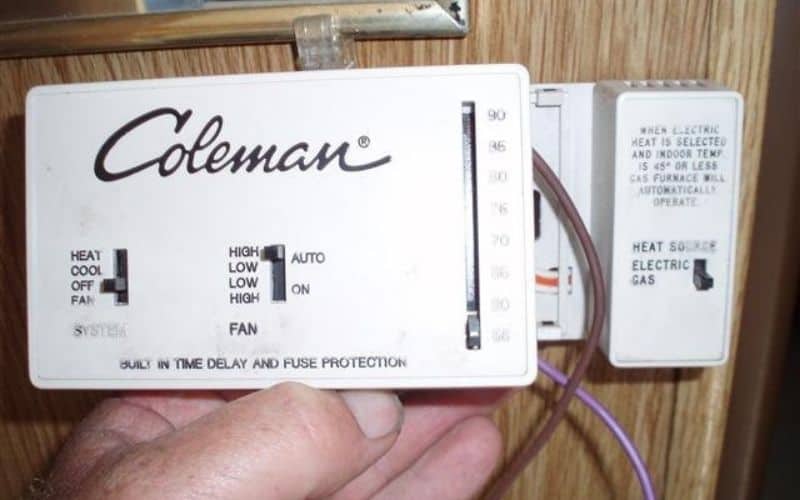
How To Choose The Best RV thermostat to regulate your Camper’s temp
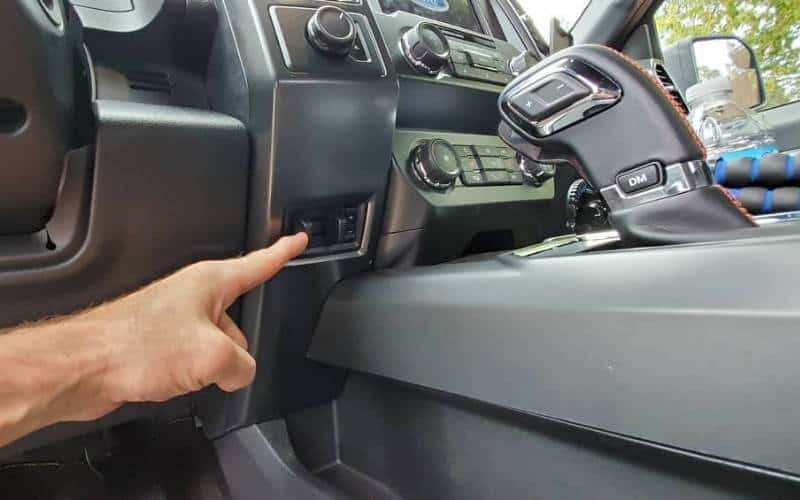
Trailer Brake Controller: Do You Really Need One, And Which Is Best?
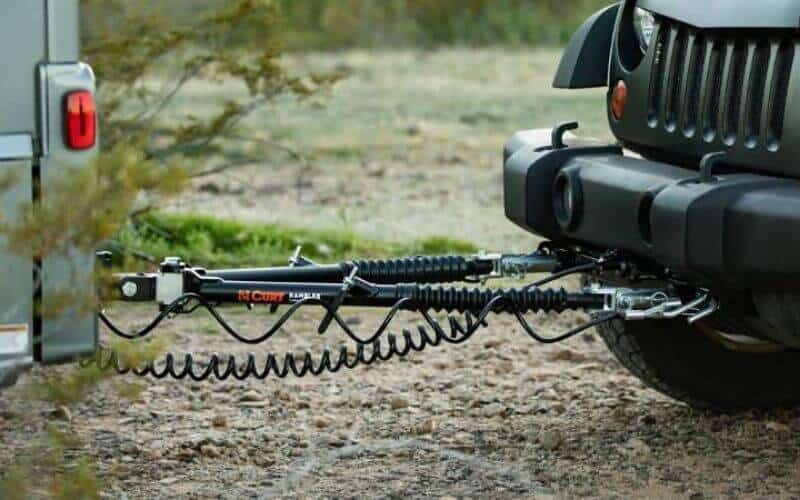
The 6 Best RV Tow Bars To Safely Tow A Car Behind A Motorhome
Start typing and press Enter to search

RV Hitch & Tow
Last updated on: January 4, 2022
The 12 Best Weight Distribution Hitches to Buy in 2022
by Chris Coleman
www.rvtalk.net is reader supported. When you buy through links on our site, we may earn an affiliate commission.
While towing your trailer, one of the most important priorities is to maintain control over your towing setup to minimize the odds of accidents. A way to ensure safe towing and good handling on the road is to get the best weight distribution hitch . By ensuring that your rig packs the right hitch before every towing operation, you can stabilize your towing setup and avoid common issues such as swaying.
To determine the best weight distribution hitch for your circumstances, you certainly need to do your homework to understand their components and working mechanism, the different types of weight distribution trailer hitches, their benefits and when you would need one, the most important buying criteria and a few dos and don’ts. This article will equip you with everything you need to know about weight distribution hitches, and provide answers to the most frequently asked questions by your fellow campers.
Best Weight Distribution Hitches Comparison Chart
What is a weight distribution hitch, when you would need a weight distribution hitch, components of a weight distribution system, how does a weight distribution hitch work , benefits of weight distribution hitches, types of weight distribution hitches, 1. andersen 3350 – best of the best , 2. curt 17007 – editor’s choice, 3. camco eaz-lift 48056 – editor’s choice , 4. camco eaz-lift 48053, 5. equal-i-zer 90-00-1000, 6. husky 31423, 7. curt 17062, 8. reese pro series 49913, 9. fastway e2, 10. husky 32218, 11. camco eaz-lift 48733, 12. blue ox swaypro bxw1500, critical weight distribution hitch considerations, top brands of weight distribution hitches, q1. do weight distribution hitches reduce tongue weight, q2. does a weight distribution hitch increase towing capacity, q3. how much weight does a weight distribution hitch distribute, q4. when do you need a weight distribution hitch, q5. can weight distribution be used with surge brakes, q6. how to stop your trailer from swaying on the road, q7. what is the best weight distribution hitch with sway control, weight distribution hitch basics.
A weight distribution hitch , also referred to as a load equalizing hitch, does exactly what the name suggests. It is a hitch that evenly distributes the weight of your payload that you tow behind your vehicle.
A weight distribution hitch does this by using adjustable spring bars and tension to distribute the load of the trailer tongue to the trailer and the towing vehicle axles. A trailer’s tongue weight (TW) refers to the weight that a fully loaded trailer exerts downward on the hitch ball of the tow vehicle. Tongue weight should be between 10% to 15% of gross trailer weight (GTW) for good control and handling on the road.
As you already know, driving a vehicle with a trailer towed behind, connected by a hitch is very different from driving a vehicle alone in terms of handling, due to the added weight and size as well as the swaying from side to side. Without the proper hitch and the best weight distribution hitch, you might have a very hard time maneuvering and thus the risk of accidents is significantly higher. The purpose of getting the best weight distribution hitch is to keep everything balanced, so that you gain more control of the towing vehicle and trailer combo as they turn and brake.
When you’re towing a trailer, what comes into play are the tow vehicle’s weight, the trailer’s weight and the weight put on the hitch ball. The relationship between these factors will affect your handling on the road. In other words, what matters to controllability here is the trailer’s tongue weight, that is the weight that a fully loaded trailer exerts downward on the hitch ball of the tow vehicle.
Firstly, if the trailer’s tongue weight is too light, that is the tongue of the trailer does not exert enough downward force on the tow vehicle’s hitch ball, the trailer could sway from side to side and this can result in dangerous accidents. On the other hand, if the tongue weight is too heavy, the steering of the tow vehicle will be affected.
The good news is you can avoid both of these issues by using the best weight distribution hitches to maintain the ideal balance between the gross trailer weight and tongue weight.
You can weigh your trailer by taking it to a commercial scale at truck stops. The rule of thumb is 10% to 12% of the trailer’s weight must be on the tongue where it hitches to your vehicle. So for example, if the gross weight of your trailer is 2,500 pounds, then at least 10% of that weight should rest on the hitch, or in other words, the trailer’s tongue weight should be about 250 pounds.
In general, if you’re experiencing one or more of the following, you’re most likely to benefit from a trailer weight distribution hitch:
- Your gross trailer weight (GTW) is more than 50% of your tow vehicle’s gross vehicle weight rating (GVWR). The Gross Vehicle Weight Rating is the maximum total safe weight of your vehicle, including the curb weight or the weight of your vehicle when empty, the weight of passengers, fuel, any accessories added to the vehicle, cargo, and the tongue weight of the towed trailer.
- Difficulty when maneuvering: You experience trailer sway, or find it difficult to steer or stop your rig.
- Your tow vehicle’s headlights point upward, and/or the rear of your tow vehicle sags when the trailer is hooked up. This means too much weight is resting on the rear of your tow vehicle, which greatly affects handling.
- You want to tow to the highest capacity allowed by your trailer hitch. If your hitch is rated for use with weight distribution, a good weight distribution system will allow you to tow at the maximum capacity of the hitch.
* Important note: Keep in mind that not all hitches are designed for use with weight distribution systems. Every trailer hitch will have a weight rating label; always check it for the weight distribution towing capacity. If there is no such capacity specified, then a weight distribution system cannot be used with the existing hitch.
A typical weight distribution system consists of five major components:
Class III, IV, or V trailer hitch receiver: As above, the trailer hitch receiver must be rated for use with weight distribution. It attaches to the frame of your tow vehicle and provides the receiver opening that the weight distribution shank slides into.
Weight distribution shank: The weight distribution shank slides into your trailer hitch receiver to create an attachment point for the weight distribution head assembly. To ensure your trailer is level with your vehicle, manufacturers make shanks available in a wide variety of lengths, rises and drops.
You can purchase a weight distribution hitch that comes with a shank, or you can purchase a hitch and a shank separately. Campers would usually opt for separate purchases when they require a greater rise or drop than provided by the standard shank included in the kit.
Spring bars: Spring bars redistribute the load on the rear of your tow vehicle to all the axles on your tow vehicle and trailer. Spring bars come in round, trunnion, and square shapes.
Frame brackets: Available in various designs, frame brackets mount to the frame of your trailer and secure the spring bars to the trailer. Standard weight distribution systems use a frame bracket and chain system to hold the spring bars in place. Meanwhile, many higher-end systems have special sway-control brackets for superior anti-sway capability.
Weight distribution head assembly: Head assemblies attach to the weight distribution shank, provide a place to mount the hitch ball for trailer hookup, and provide the spring bar attachment point. The head assembly will also be used to fine-tune the amount of leverage applied to the system. Different weight distribution systems use different types of head assembly, so the design differs between products.
As a highly sought-after feature, many standard head assemblies have built-in platforms for mounting friction sway control bars. Friction sway control bars mount to a smaller ball on the side of the weight distribution head. Some heads have dual platforms so that you can mount a sway control bar on either side or both sides)of your trailer, while some models only allow for a right-side attachment.
To understand how a weight distribution hitch comes into play when you tow a heavy trailer behind your vehicle, it’s important to understand the physics behind the setup. When you tow a trailer with a standard, rear-mounted hitch, the trailer’s tongue weight is rested on or transferred to the rear axle of your tow vehicle. Too much weight can make your vehicle’s back sag and cause the front to point upward, especially on vehicles that have suspension designed for everyday comfort.
When the front of your tow vehicle points upward, this means that most of the weight of the tow vehicle is resting on its own rear axle, and on top of that, it is also bearing the weight of the traileras well. This, plus the lessened weight on the vehicle’s front axle obviously has a negative effect on traction, steering and your ability to brake, and can increase the magnitude of trailer sway. The vehicle’s front pointing upwards might also mean that your view of the road may be limited due to the awkward angle.
So how does a weight distribution hitch help? A weight distribution hitch would redistribute the weight away from the tongue and onto the axles of the towing vehicles. This reduces the load that the rear of towing vehicles has to bear. This even redistribution of weight results in a smoother, level ride, and also allows you to tow at the maximum capacity of your hitch.
One important note that we must emphasize: Many campers misunderstand that weight distribution hitches can “reduce” tongue weight. This is not true. In other words, these systems won’t allow you to tow beyond the capacities of the tow vehicle.
If your hitch is rated for use with weight distribution, a good weight distribution system will allow you to tow at the maximum capacity of the hitch. So a weight distribution hitch allows the hitch to be used at its maximum capacity but doesn’t increase the hitch’s capacity.
Learn more on how it works here !
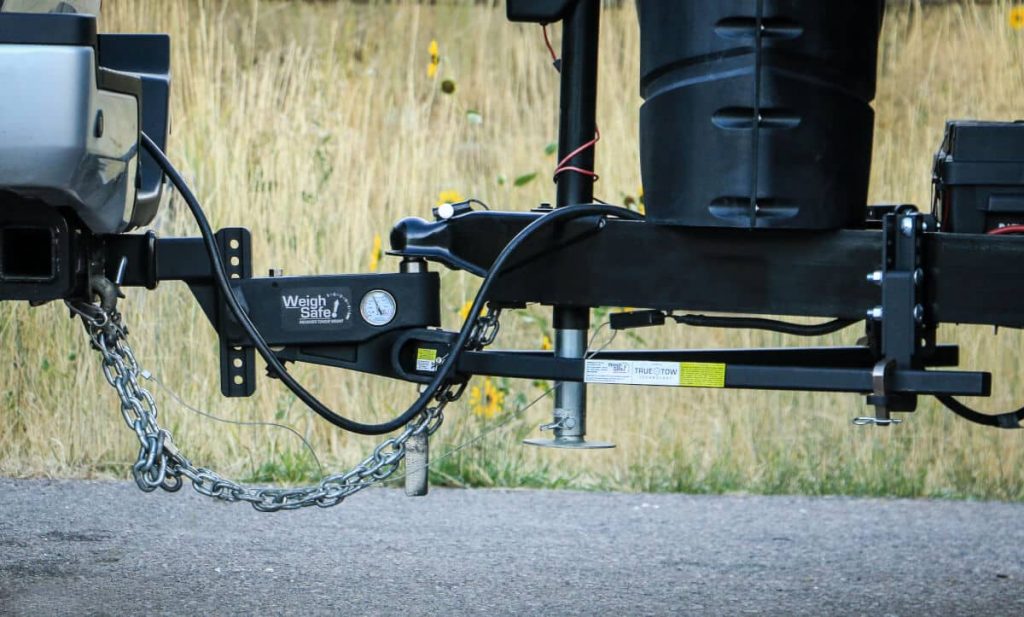
Controllability : With weight distribution trailer hitches around, the weight of towing setups should be equally spread among the axles instead of concentrating at the rear of your tow vehicle. This allows for a more balanced weight distribution and thus helps you gain more control of your towing setup.
Safety : Maneuvering with a trailer behind is no easy game; it demands practice and skills. It’s much more challenging than normal driving and the risk of accidents is higher, but using a solid weight distribution hitch for hauling heavy loads would allow you better handling. Even when you come across something unexpected, having a good hitch would allow you to have better control of the whole setup and to better respond in a timely manner.
Cost : Managing trailers is never easy and all it needs is one moment of carelessness for your trailers to sustain damages that incur expensive repairs. By picking up a trailer weight distribution hitch for enhanced control , you should have no trouble keeping your pricey trailers out of harm’s way.
Generally, weight distribution hitches come in all sizes and shapes but today’s market contains three types of models: round bar, trunnion bar and Andersen.
Round Bar Hitches
Basic and practical, round bar hitches work superbly in multiple towing setups. Carrying round sway bars that attach to the bottom of ball mounts of trailers, models of the type could consistently distribute weight of the vehicles. On the downside, due to less than ideal ground clearance, round bar hitches don’t do very well on backroads.
Trunnion Bar Hitches
In use, trunnion bar hitches operate similarly to round bar ones but instead of round, their sway bars happen to be square. Moreover, since the sway bars attach to the center of ball mounts of trailers, models of the type tend to boast top-notch ground clearance. However, it usually takes a bit of time to change the height of the hitch head.
Andersen Hitches
Unlike other hitches, Andersen hitches do away with sway bars in favor of highly flexible chains and dampers. With models of the type, people would be able to keep bouncing and swaying to the minimum while traveling. Andersen hitches have steep prices though so it’s necessary to be thorough about shopping budgets.
Reviews On The Best Weight Distribution Hitches
Preferences often differ significantly between people so there is no such thing as the best weight distribution hitch for everyone. Still, if you wish to get to know top-performing hitches then you have to check out the following models.

Why This Is The Best:
Designed from the ground up with practicality in mind, Andersen 3350 works like a charm in a wide range of situations. Possessing excellent weight ratings, the Andersen weight distribution hitch allows people to haul all sorts of loads with relative ease. Additionally, with a combination of self-adjust sway control and motion-dampening system, 3350 provides users with fantastic control over trailers. As a result, those that hit the road with heavy-laden trailers think of Andersen 3350 as the best weight distribution hitch at its rice range.
In terms of installation, the setup process of 3350 is undemanding and there is no need to resort to pry bars. On arrival, the hitch of Andersen is accompanied by everything so it’s unnecessary to make separate purchases for hardware. When positioned and secured, Andersen 3350 is going to serve you until the day it breaks down without requiring special attention. Interestingly, since 3350 is engineered with one-pin removal, you could detach it in a blink of an eye as well.
As proof of confidence, Andersen offers its hitch with a marvelous lifetime warranty that covers manufacturing defects which speak volumes. If your 3350 experience issues in the course of operation, you have something to count on.
- Installation is child’s play
- No-nonsense maintenance
- Customer service is less than ideal
- Users detect several inconsistencies between hitches

Why It’s An Editor’s Choice:
Featuring head and spring bars that employ top-of-the-line steel, Curt 17007 is praised for its outstanding structural integrity. Also, the integration of carbide powder coat finish means 17007 could handle heat, humidity, sunlight and so on without much difficulty. Thus, regarding longevity, the weight distribution hitch made by Curt is among the top-ranked models in its price range. Curt 17007 packs a decent weight capacity as well, hence, it suits plenty of towing operations.
The hitch of Curt incorporates an adjustable shank that is compatible with all standard two-inch trailer hitch receivers and that makes it highly versatile. Moreover, with snap-on brackets, 17007 mount onto the frames of trailers in a flash and via the lift handle, leveraging it is a cakewalk too. That is why no matter the arrangement, the setup process of Curt 17007 rarely drags out and everything the users need lies in the rig toolbox. Since the hitch from Curt is a breeze to maintain on the road, keeping it operational is an easy task.
When you opt to pick up Curt 17007, you would receive a terrific lifetime manufacturer warranty so you don’t have to be concerned about defects. Aside from that, the Curt hitch is fairly inexpensive so its purchase would have inconsequential effects on your upcoming spendings.
- Smooth operation
- Detailed installation instructions
- Certain hitches arrive with signs of damages
- Hardly adequate packaging
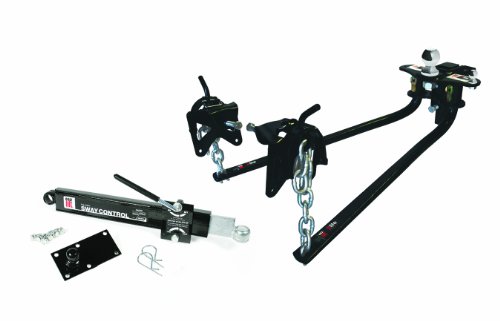
Dependable and reliable, Camco Eaz-Lift 48056 usually gives a good account of itself in use which earns it numerous compliments. Upon purchase, the hitch made by Camco comes pre-installed with the hitch ball, sway control, U-bolts and chains. Because of that, people could begin installing Eaz-Lift 48056 the moment it leaves the packaging and wrap up the setup process in a few minutes. In addition, boasting a black exterior that is aesthetically-pleasing, Camco Eaz-Lift 48056 matches the color themes of various rigs.
Constructed using premium steel, Eaz-Lift 48056 features wonderful endurance compared to the average weight distribution hitches on the market nowadays. From elements in the outdoors to physical impacts, the hitch from Camco is capable of dealing with all towing challenges. Therefore, even if Camco Eaz-Lift 48056 is used on a daily basis, years would pass before it must be replaced. Needless to say, Eaz-Lift 48056 is highly sought after by those that hate to spend money on frequent hitch replacements.
Available at an affordable price, Eaz-Lift 48056 of Camco is the best weight distribution hitch for people with tight wallets. Besides that, so as to reassure users, Camco willingly backs its weight distribution hitch with a five-year manufacturer warranty.
- Long-lasting
- Setup process is instantaneous
- Quality control still leaves something to be desired
- Reports of loosening bolts appear sporadically

Why We Love It:
With the ability to deliver significant boosts to controllability of towing setups, Camco Eaz-Lift 48053 is held in high esteem by a lot of people. As it consists of far fewer parts than its contemporaries, Eaz-Lift 48053 possesses first-class reliability in the course of operation. Packing positive latching action, the towing hitch of Camco is also simple to operate. Naturally, once it comes to convenience, Camco Eaz-Lift 48053 is known as the best weight distribution hitch money can buy.
Regarding capacity, the hitch made by Camco is put together with a GTWR of 10,000 pounds and a TW of 1,000 pounds. That is going to be more than enough to let users tow an assortment of trailers at their max load. Furthermore, the ball height of Eaz-Lift 48053 is adjustable so adapting it to variable arrangements is a piece of cake. About maintenance, pretty much all the hitch of Camco need to stay in working order is periodical cleaning and lubrication.
For post-purchase support, Camco Eaz-Lift 48053 is backed with a five-year manufacturer warranty. If your Eaz-Lift 48053 fails due to defects within the warranty period, you could claim a replacement free of charge. It’s worth pointing out since the Camco hitch is a low-priced model, the cost of replacement remains budget-friendly after the warranty expires.
- Inexpensive
- Decent capacity
- Easy to install
- People sometimes complain about missing hardware
- Packaging is mediocre
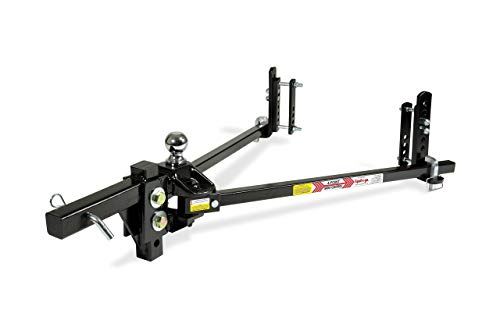
Tired of frantically fighting with swaying while maneuvering your towing setup on the road and need an anti-sway hitch ? Then there is a good chance that you would come to like Equal-i-zer 90-00-1000. Owing to the solid 4-point sway control, the hitch from Equal-i-zer is able to effectively and efficiently restrict horizontal motions of the trailers. That is why with 90-00-1000 installed on your rig, you should have no trouble keeping everything under control at all times.
The setup process of Equal-i-zer 90-00-1000 involves no drilling or tapping so it only takes mere moments to complete. Assuming that the installation is done correctly, 90-00-1000 should work smoothly without making a racket in use which ensures quiet operation. Unsurprisingly, those that seek tranquility think of the Equal-i-zer as the best weight distribution hitch available for purchase. Aside from that, being specifically created for universal application, the compatibility of 90-00-1000 of Equal-i-zer is terrific as well.
In terms of maintenance, the towing hitch made by Equal-i-zer could be cleaned and lubricated in no time. Hence, if you grab 90-00-1000, you may spend more time towing and less time maintaining accessories. Though its steep price, the values that Equal-i-zer 90-00-1000 provide match what it costs.
- Low noise level
- Sturdy and stable
- Maintenance is no sweat
- Fitness difficulty is noted
- Particular hitches show up without hardware

Capable of equally distributing heights of various towing setups, Husky 31423 earns positive remarks from plenty of weight distribution hitch reviews. Featuring a hitch head that could accept spring bars of variable capacities, 31423 adapts rather well to a diversity of operations. Moreover, with multiple built-in height levels, the hitch made by Husky allows people to quickly raise and lower it depending on the current situation. As a result, regarding versatility, Husky 31423 proves to be second to none on the market.
Covered in black polyester finish that packs wonderful resistance against corrosion, the Husky weight distribution hitch rarely experiences rust problems in the course of operation. Thus, 31423 is kind of popular among people that have to haul heavy loads through coastal regions from time to time. Also, the installation of Husky 31423 is quite intuitive so you don’t have to be a mechanic to position and secure it on your own. The hitch from Husky is accompanied by hardware too and that is a big plus.
Husky 31423 is backed with both a lifetime manufacturer warranty and a ninety-day commercial guarantee. In the case that you value sound insurance policies, you should add 31423 to your shortlist. Compared to typical models, the weight distribution hitch of Husky is low-priced so you don’t have to empty your wallet to buy it.
- Splendid ruggedness
- Capacity is sublime
- Delivery service requires improvements
- Pins of hitches drop out now and then

Being fashioned to offer a comfortable ride by allocating trailer weight across the axles, Curt 17062 never lets its user down. Thanks to the presence of forged steel spring bars, the Curt weight distributing hitch could handle significant amounts of weight in use without giving out. Additionally, since 17062 is powder-coated, it’s less vulnerable to elements in the outdoors than other hitches of its type. Because of that, Curt 17062 is prized by those that travel year-round and don’t have a lot of opportunities to pick up replacement hitches.
One interesting thing about 17062 is that it contains several easy-access grease fittings that facilitate continuous lubrication on the road. Hence, keeping the hitch made by Curt up and running as time passes by would be a piece of cake. The noise level of Curt 17062 is fairly low so you should seldom feel bothered by noise while hauling ladened trailers. Last but not least, explicitly built with an emphasis on adjustability, 7062 is compatible with a wide range of towing setups.
Upon purchase, Curt 17062 came alongside hardware for installation so you could set it up in just a matter of minutes. Curt backs its towing hitch with a lifetime manufacturer warranty that brings people much-needed peace of mind as well.
- Tech-support is responsive
- Well-written owner’s manual
- Missing hardware is noted
- Threads of hitch screws tend to strip

Assembled for today’s demands and built to last for years, Reese Pro Series 49913 adapts marvelously to modern towing operation. Packing a fantastic friction sway control that prevents swaying caused by crosswind, sharp maneuvers and curved roads, Pro Series 49913 permits people to maintain total control. Furthermore, with high-endurance forged and tapered steel spring bars, the hitch from Reese could handle hardship without breaking down. As a result, those who desire well-rounded weight distribution hitches consider Pro Series 49913 of Reese as the best weight distribution hitch for travel trailer .
Since the Reese hitch is a preinstalled model that arrives with hardware already attached, its setup process is pretty short. The inclusion of an ergonomic integrated handle greatly reduces the time it takes to engage and disengage Pro Series 49913 too. In times of need, it’s possible to remove Reese Pro Series 49913 from towing vehicles by releasing two locking pins. Thus, if you like to stay flexible as you haul heavy loads, the weight distribution hitch of Reese is going to be what you need.
About affordability, Reese Pro Series 49913 reaches the market at a price that everyone could accept. That means squeezing the hitch made by Reese into the spending plan would be essentially a walk in the park.
- Quick shipping
- Commendable durability
- Simple to manipulate
- Instructions could use some work
- Users complain about receiving incorrect hitches from time to time

Basic and practical, Fastway e2 is capable of stopping most towing setups from getting out of control in the outdoors. With tip-top built-in sway control that features steel-on-steel friction, e2 continuously fights sway which optimizes controllability. In addition to that, the hitch made by Fastway is put together as one all-inclusive system so there is no need for add-ons. That is why people don’t have to dedicate much time and stamina to the installation/removal of Fastway e2.
Unlike other weight distribution hitches on the market, Fastway e2 evenly divides the weight of trailers regardless of the angles. Therefore, owners of the Fastway hitch may tow heavy-laden trailers without having to worry about any restrictions in maneuverability. In use, by creating a steady bridge between your trailer and rig, e2 would let them work together as one unit instead of two vehicles. With Fastway e2 around, you should have an easy time bringing your trailers to destinations.
The weight distribution hitch of Fastway boasts a black finish on its exterior surface so it excels at blending in. If you hate to see your hitch standing out like a sore thumb, e2 is undoubtedly the best anti-sway trailer hitch you could get.
- Slim and sleek
- Reasonable price
- Stability is impressive
- Barely acceptable packaging
- Customer service is unresponsive
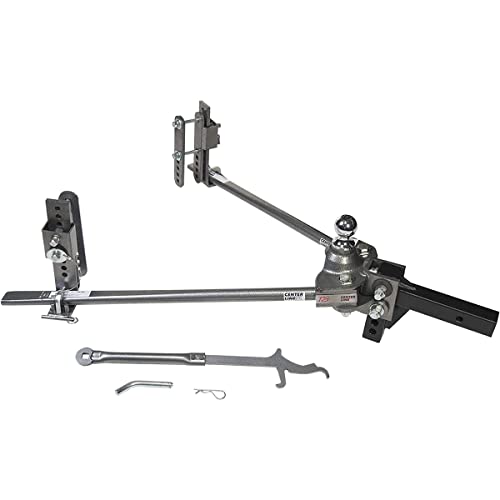
Possessing a heavy-duty body that consists of forged and hardened steel components, Husky 32218 is superior to ordinary weight distribution hitches in terms of ruggedness. In the course of operation, the hitch from Husky could withstand everything that people and the outdoors throw at it. Thus, for towing operations that involve both rough roads and challenging elements, 32218 is recognized as one of the leading options. Aside from that, Husky 32218 works in a quiet manner so noise is less than an issue and that is advantageous.
On arrival, 32218 comes with a preinstalled and torqued hitch ball that accelerates the setup process and eliminates the need to purchase the ball separately too. Moreover, owing to the incorporation of a handle, users would be able to engage and disengage the hitch of Husky in a couple of seconds. As a result, for those that lack the patience to hook up complicated hitches, Husky 32218 is the best anti-sway trailer hitch available for purchase. Being a breeze to clean and lubricate, 32218 requires minimal labor once it comes to maintenance.
With a GTWR of 12,000 pounds and a TW that stretches from 800 to 1,200 pounds, Husky 32218 could superbly support standard towing setups. The frame of the Husky hitch is also fully adjustable so its flexibility is outstanding.
- Intuitive handling
- Noise level is low
- A number of hitches arrive damaged
- Shank is slightly short

Loaded from top to bottom with innovative features and functions, Camco Eaz-Lift 48733 never fails to please people in use. By utilizing top-loading spring bars, Eaz-Lift 48733 provides extra ground clearance for towing setup which certainly helps a lot. Additionally, equipped with automatic sway control that engages and disengages on its own based on current condition, the Camco hitch is good at addressing swaying. Hence, Camco Eaz-Lift 48733 is the best sway control hitch for people that place handling above all while towing trailers.
As for capacity, the ratings of the hitch made by Camco seem unexceptional but they remain adequate: 10,000 pounds for GTWR and 1,000 pounds for TW. If you opt to pick up Camco Eaz-Lift 48733 then you could haul a wide range of loads with relative ease. Besides that, constructed using materials with admirable durability, Eaz-Lift 48733 would last a long time. Lastly, the hitch from Camco carries a handy powder-coating that resists corrosion so you don’t have to bother with rust on the road.
The installation of Camco Eaz-Lift 48733 is undemanding, therefore, setting it up is a cinch and there is no need to invest in additional hardware. When Eaz-Lift 48733 is installed properly, it operates without squeaking or squealing so its users should have no trouble focusing.
- Terrific lifespan
- Hitch mounts twist over time
- Several people report getting incomplete hitches

Your trailer is kind of heavy so you need a trailer hitch with sway bars that pack high weight ratings? Then it’s suggested that you take a look at SwayPro BXW1500 of Blue Ox. With GTWR of 15,000 pounds and a TW of 1,500 pounds, the weight distribution hitch from Blue Ox could accommodate substantial weights and maintain stability in environments. Also, with flexible spring bars that don’t have to be greased, SwayPro BXW1500 performs fluidly without needing dedicated maintenance.
With its head receiving adjustments before delivery, Blue Ox Sway Pro BXW1500 is ready-to-use as soon as it’s out of the packaging. Hence, during the installation of the Blue Ox hitch, there is no need to waste significant time on fine-tuning. It’s noteworthy that Pro BXW1500 happens to integrate quick latching that permits rapid hitch engagement and disengagement as well. Even when you have to back up your rig, it’s unnecessary to disconnect SwayPro BXW1500 of Blue Ox altogether.
In the course of operation, Blue Ox Pro BXW1500 seldom let out sounds which contribute to a low noise level. So with the hitch made by Blue Ox, you could give your ears a break as you maneuver your trailer
- Great ground clearance
- Magnificent capacity
- Resistance to elements is excellent
- Shipping needs to be overhauled
- Kind of cumbersome
Weight distribution hitches pack various features and functions but if you hope to get your money worth, it’s imperative that you remember these criteria
WEIGHT CAPACITY
Overall, different trailers come at different weights which is why you need to pay special attention to the weight capacity of your load distribution hitch . If you pair your towing setup with hitches that possesses inappropriate capacities then handling characteristics would worsen instead of improving. Normally, you could deduce the ideal weight capacity for your hitch by using GTW (Gross Trailer Weight) and TW (Tongue Weight) rating as guidelines. You should be able to locate those ratings in the owner’s manual of your trailer.
One more common question is whether a weight distribution hitch can be too big for your trailer. The answer is you can’t have ‘too much’ of a weight distribution hitch. However, the spring bars must be matched closely with the trailer for the system to work properly. Too weak and not enough weight is transferred to the front axle of the tow.
SWAY CONTROL
The last thing you want to experience while hauling heavy loads is to see your towing setup swaying uncontrollably in the midst of a turn. Because of that, as you search the market for the best weight distribution hitch , it’s strongly recommended that you take sway control into account. Nowadays, models utilize many methods to address swaying:
Some stop the sway as it unfolds: One prime example is the friction bar that attaches to the frame of trailers and weight distribution hitches. When the trailer moves out of the line, a downward force would be applied to the friction bar which limits further side-to-side movements.
One more thing to note is a weight distribution hitch system is either featuring dependent sway control or independent friction sway control. Each type deals with swaying differently.
With dependent sway control models, once the swaying starts, the spring bars will produce a downward force, which provides frictional resistance to the brackets located on your trailer frame’s sides. The friction comes from steel-on-steel resistance plus resistance from material that has the same consistency with brake pads.
Meanwhile, independent sway control models create friction through the use of a bar that bolts onto your trailer’s frame and is also attached to the hitch system, producing enough resistance to keep your trailer from swaying. This type of anti-sway system also features an interior bar that helps out by telescoping in and out to stop any bucking or binding of your trailer.
An independent anti-sway hitch system also features friction pads that will come into contact with each other you’re towing to produce extra resistance, further reducing any swaying.
Some models prevent it from happening in the first place: Some of the best weight distribution hitch with sway control integrate cams to secure spring bars, which will suspend and lock the spring bars into place. One end of a cam will attach onto the lift bracket via the lift chain and the other to your trailer’s frame. The spring bar’s rounded metal ends then sit inside the cams. This controlled location of the spring bars keeps the entire setup secure, so that your trailer will not sway from side to side.
Besides that, certain weight distribution hitches come with an innovative built-in 4-way sway control that rely on a stable connection in the head unit to get enough tension.
Meanwhile, the other two-points anti-sway systems work to provide resistance as well. These two points will work to ensure there’s enough tension produced throughout the hitch’s system, which will ensure swaying never becomes an issue.
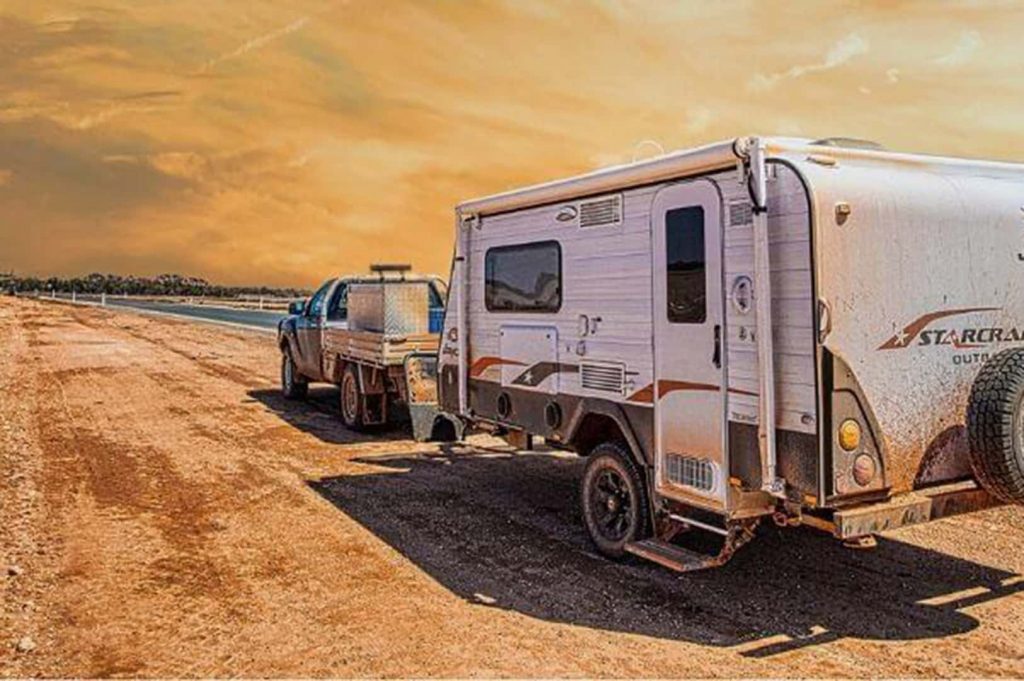
PRE-INSTALLED COMPONENTS
The time and stamina that go into the installation of weight distribution hitches tend to vary from model to model. That being said, models that arrive with pre-installed components usually don’t require much to get up and running. Hence, if you have a schedule to follow, it’s widely advised that you keep an eye out for hitches that come installed with components. To determine whether a particular model is delivered with pre-installed components, you should check out its owner’s manual.
INSTALLATION
You always have the option of hiring others and let them take care of the hitch installation in your stead. However, considering that you have already put aside money for a hitch, why don’t you grab one that you could set up on your own and cut unnecessary spendings? In most cases, you would get a general idea about the complexity of setup process of a weight distribution hitch via the owner’s manual. For good measure, it’s suggested that you read several customer reviews and see what people say about the setup process of models you like.
DURABILITY
In the course of operation, weight distribution hitches must constantly manage substantial weights and deal with plenty of outdoor elements. That is why as you assess models on the market, you have to keep durability in mind at all times. If you hit the road with a flimsy hitch that is prone to fail, not only you need to spend money on replacements but you also risk your well-being. By inspecting the construction material, it’s a breeze to see how well models hold up as time passes by.
- Below $500 : With the ability to take on the average towing loads, weight distribution hitches in the price range work superbly in an assortment of operations. In addition, models that cost less than $500 have excellent compatibility so it’s simple to pair them with standard setups.
- Above $500 : Intentionally optimized for demanding operations, weight distribution hitches in the price range could withstand significant weights and unforgiving elements. While dropping more than $500 on a weight distribution hitch may seem excessive, you could save money in the long run thanks to lengthened replacement intervals.
Today’s weight distribution hitches come from a wide range brands but in terms of reputability, a couple of names stand out from the rest
With decades of experience in designing towing hitches and associated accessories, Camco knows exactly what people face on the road. In the case that you seek a no-nonsense anti-sway hitch that could even out the trailer weight, you should prioritize models from Camco.
Known for assembling hitches that rely on chains and dampers instead of sway bars, Andersen is held in high esteem by a lot of people. Once it comes to adaptability, Andersen hitches don’t have many competitors on the market.
Equal-i-zer
Owing to the user-oriented approach, Equal-i-zer is capable of releasing solid hitches that rarely let people down. In addition to that, reaching the market at reasonable prices, models made by Equal-i-zer match multiple shopping budgets.
By emphasizing utility, Blue Ox and its weight distribution hitches receive a shower of praise from those who have to routinely haul heavy loads. It’s noteworthy that Blue Ox models arrive with virtually everything too so they don’t take long to set up.
FAQs About Weight Distribution Hitches
Weight distribution hitches do not reduce tongue weight or in other words, allow you to tow beyond the capacities of the vehicle. What these systems do is distribute the tongue weight of a trailer up to the front axle of the tow vehicle so that it will sit more level and thus handle and brake better.
No. As weight distribution hitches do not reduce tongue weight, in other words, these systems won’t allow you to tow beyond the capacities of the tow vehicle. If your hitch is rated for use with weight distribution, the weight distribution system will allow you to tow at the maximum capacity of the hitch. Weight distribution doesn’t “increase” your hitch’s capacity so much as it allows the hitch to be used at its maximum capacity.
A weight distribution system typically offers even weight distribution: it redistributes about 1/3 of the tongue weight onto the trailer axles, 1/3 of the tongue weight onto the tow vehicle’s rear axle, and the remaining 1/3 onto the tow vehicle’s front axle.
Every truck of any size requires a weight-distributing hitch when using a bumper trailer hitch ball. Using a weight distribution hitch becomes more necessary as your trailer weight gets closer to your tow vehicle weight, and is a must if your gross trailer weight when fully loaded is more than 50% of your tow vehicle gross weight. In addition to a weight distribution system, trailer brakes are also recommended in these cases. As a rule of thumb for safety, most mid-size and half-ton trucks require it when gross trailer weight exceeds 5,000 pounds, while heavy-duty trucks will require a weight distribution system when trailer weight exceeds 6,000 pounds. The limit for the most heavy-duty trucks might be around 8,500 pounds.
Not every weight distribution hitches can be used with surge brakes. This is because most chain-style systems are not compatible with surge brakes as they do not allow for enough back and forth movement of the trailer to activate the actuator. Only specified systems rated as surge brake compatible can be used with surge brakes. One note is even if a chain-style weight distribution system is rated as surge brake compatible, adding friction sway control bars to these systems will make the system incompatible with surge brakes. To make sure your brakes operate at maximum effectiveness and are not prevented from compressing, you must not use a chain/snap-up bracket system with your surge brakes.
1. Adjust tongue weight Not enough tongue weight is the most common cause for trailer sway. The tongue weight must be 10 to 12 percent of the trailer’s weight for the most balanced and level drive. For example, if the gross weight of your trailer is 2,500 pounds, the tongue weight on the hitch should be about 250 pounds. As a quick fix before you can buy the best weight distribution hitch for your trailer, you can try to redistribute the weight as necessary by removing some items, place heavier cargo at the front of the trailer, center the cargo left-to-right, and use reinforcements to firmly secure the cargo to prevent them from moving around. 2. Proper tyres inflation In addition to getting the best weight distribution hitch that you can afford, the very first thing you should do is ensure that the tyres of both your tow vehicle and your trailer are properly inflated. Underinflation is a common culprit for unlevel and unbalanced drive, while overinflation might make the ride more bumpy. 3. Install a friction sway control device The most ideal course of action is to get a best weight distribution anti sway hitch. Otherwise, you can get a friction sway control device designed for use in trailers that have a low tongue weight percentage. For trailers that are over 5,000 pounds, sway control devices should be attached to both sides of the trailer hitch. These friction sway control devices reduce the effects of sudden gusts of strong wind and sharp turning by applying resistance to the trailer and vehicle with respect to each other. When driving, stop and turn the adjustment handle a quarter of a turn in the clockwise direction, which adds more friction. Continue to do this until your trailer feels straight and stable. 4. Sway control bar Most weight distribution hitches allow the trailer to be backed into place without having to be taken off. But when you’re backing into tight turns, you might experience swaying because of the sway control bar. If you have a sway control bar, it’s recommended to disengage it before reversing or tight maneuvering. 5. Do not overload your trailer Keep in mind that your load capacity includes the weight of the trailer, tongue, vehicle, and your passengers. 6. Avoid windy conditions If you can’t, here are some tips for safe driving with minimal swaying in these conditions: Steady the steering wheel at all times: do not make sudden turns, and do not try to steer out of a sway situation. Never slam on the brakes when you’re experiencing trailer sway but gradually and steadily reduce speed instead. Try to keep the speed at a moderate level whenever you’re not on the highway, since higher speeds make trailer sway more severe. Apply only the trailer brakes to help reduce sway. If the problem persists, it’s safest to pull over to evaluate the cause of the sway. Whether or not you can pinpoint the culprit right away, it’s best to head to the nearest repair shop to have the problem looked at.
Weight distribution hitches that pay special attention to sway control usually shout it in their name, like the Fastway E2 2-point Sway Control that’s famous for its 2-point sway control feature. This model indeed receives raving reviews from buyers and is one of the best sway control hitch products on the market, but remember that you must browse through the reviews to see if the product really delivers what it’s advertised to do. There are also models with advertised adjustable sway control, like the Camco Chem 48751 ReCurve R3 Weight Distribution Hitch Kit , also a favourite among campers. What RVers love about this product is that it delivers an unprecedented amount of sway control placed on your trailer by adjusting the clam, and you can turn this feature off or on whenever it fits your situation.
Also in RV Hitch & Tow , we’re providing thorough reviews and buying guides which help RV campers have peace of minds choosing the best fifth wheel hitches for short bed trucks , best removable fifth wheel hitches , best anti-rattle hitch devices , best trailer hitch locks , best electric tongue jacks , best tow dollies on the market today.
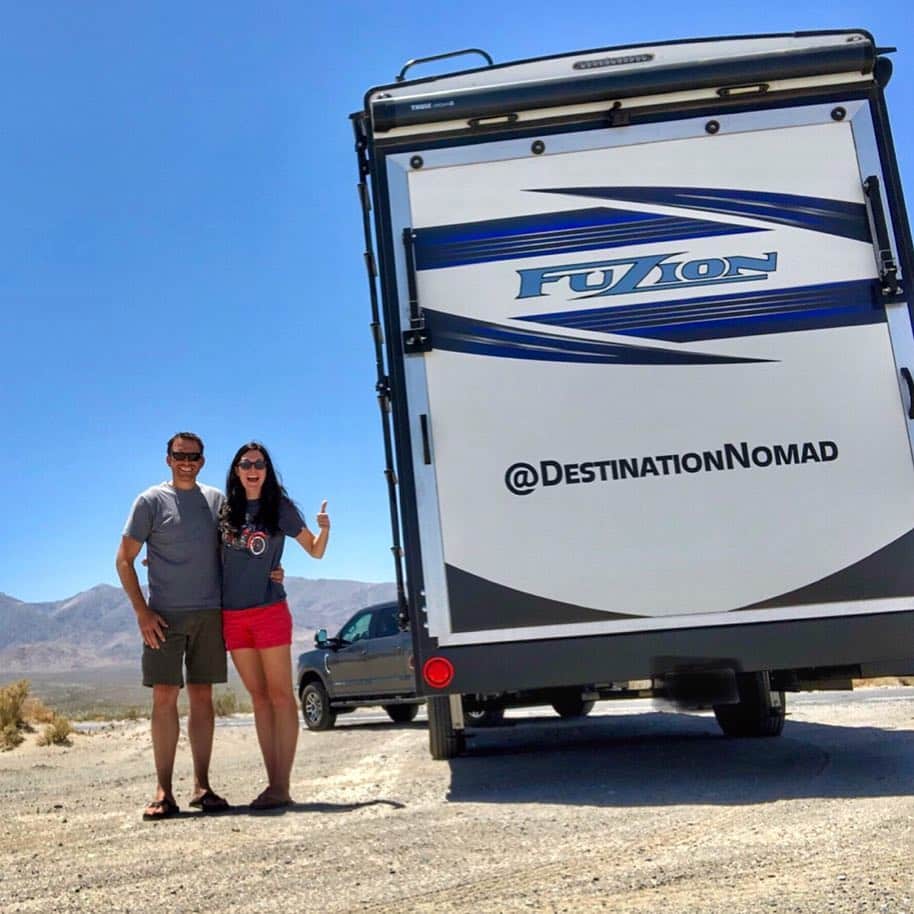
About Chris Coleman
Chris Coleman is an interesting travel blogger and outdoor photographer with a great sense of humor. He owns an RV Accessories shop in New York City so he has the knowledge necessary to provide thorough reviews and give advice on how to choose the right products for RV travel. He puts all that RV knowledge and experience to good use in his sharing posts. Besides product buying guides/reviews, Chris also writes informative articles, how-to articles and RV camping guides in his own interesting viewpoint. Chris’s blog is one of the most reliable information sources for RV campers no matter if you're an expert or a determined beginner.
Related Articles in this Category
6 types of fifth wheel hitches, when to use them and which ones to buy, best 5th wheel to gooseneck adapters: an in-depth review, the 6 best removable fifth wheel hitches to buy in 2022, the 12 best anti-rattle hitch devices to buy in 2022, the 5 best rv tow dollies to buy in 2022, the 12 best electric tongue jacks to buy in 2022, the 7 best trucks for towing 5th wheel trailers, the 12 best trailer hitch locks (review) in 2022, gas vs diesel for towing a fifth wheel: which one is better, how does weight distribution hitch work, how to increase towing capacity on a vehicle, trailer hitch installation cost: the ultimate guide, the 12 best fifth wheel hitches for short bed trucks, gooseneck vs. 5th wheel hitch: what’s the difference, 1 thought on “the 12 best weight distribution hitches to buy in 2022”.
Dear Mr. Coleman:
I am curious as to why the Hensley Arrow Towing System (which eliminates sway when towing) did not make your list of the best weight distribution hitches. Perhaps because it is not a traditional weight distribution hitch but in a separate towing system category.
FYI — We towed our 29′ K-Z Sportsmen travel trailer (with fiberglass exterior and a slide out) for many years throughout the western US and across country (from Virginia to Utah) and experienced absolutely no sway when towing with our 12 Passenger Ford Econoline Van (V-10 engine).
Leave a Comment Cancel reply
Save my name, email, and website in this browser for the next time I comment.

IMAGES
VIDEO
COMMENTS
The Best Travel Trailer Hitches for Your Camper Vehicles. A receiver hitch for travel trailer helps provide an anchor to secure towed loads. Installing a reliable travel trailer towing hitch can help prevent many on-road vehicle-pulling accidents.
We've carefully weighed features like sway control, installation ease, and price to determine which hitches made the cut, and we've boiled it down to a few choices that are guaranteed to give you a smooth, sag-free, sway-free road trip with your travel trailer.
Discover the top 8 stabilizer hitches for travel trailers in 2024. Find the perfect weight distribution hitch to safely tow your trailer weight.
Ball hitches: The most common type of hitch, these attach to a ball mount and are suitable for most travel trailers. Gooseneck hitches: Designed for larger, heavier trailers, these hitches are bolted to the frame of your truck.
The Gross Vehicle Weight Rating is the maximum total safe weight of your vehicle, including the curb weight or the weight of your vehicle when empty, the weight of passengers, fuel, any accessories added to the vehicle, cargo, and the tongue weight of the towed trailer.
There are a variety of towing hitches available to suit different types of travel trailer and vehicle combinations. We’ve included information on each in the section below, so you can choose the best travel trailer hitch for you.